Narrative vs Descriptive Writing: Understanding the Key Differences
By: Author Paul Jenkins
Posted on May 13, 2023
Categories Storytelling , Writing
Narrative and descriptive writing are two of the most common writing styles used in literature. Both styles are used to convey a story, but they differ in their purpose and approach. Narrative writing is designed to tell a complete story, while descriptive writing conveys an intense description of a particular place, object, or concept.
Narrative writing involves telling a story with a beginning, middle, and end. It is often used in novels, short stories, and memoirs. Narrative writing can entertain, inform, or persuade the reader. It is a powerful tool for writers to convey their message and connect with their audience.
On the other hand, descriptive writing creates a vivid image in the reader’s mind. It is often used in poetry, descriptive essays, and travel writing. Descriptive writing allows the writer to use sensory details to create a picture in the reader’s mind. It is a powerful tool for writers to create a mood or atmosphere. Descriptive writing can entertain, inform, or persuade the reader.

Narrative Writing
Narrative writing is a style of writing that tells a story or describes an event. It can be fiction or non-fiction and is often written in the first-person point of view. The purpose of narrative writing is to entertain, inform or persuade the reader.
Narrative writing aims to engage the reader by telling a story that captures their attention. Narrative writing is often used in fiction writing, but it can also be used in non-fiction writing, such as memoirs or personal essays. The purpose of narrative writing is to create a vivid picture in the reader’s mind and make them feel like they are part of the story.
Narrative writing has several key elements that help to create a compelling story. These elements include characters, plot, point of view, narration, chronological order, action, setting, and theme. Characters are the people or animals that are involved in the story. The plot is the sequence of events that make up the story. Point of view is the perspective from which the story is told. Narration is how the story is told, such as first-person or third-person narration. Chronological order is the order in which events occur in the story. Action is the events that take place in the story. The setting is the time and place in which the story takes place. The theme is the underlying message or meaning of the story.
Examples of narrative writing include novels, short stories, and narrative essays. In fiction writing, the protagonist is the main character who drives the story forward. In a narrative essay, the writer tells a personal story that has a point or lesson to be learned. Narrative writing often uses first-person narration to create a more personal connection between the reader and the story.
In summary, narrative writing is a style of writing that tells a story or describes an event. It has several key elements that help to create a compelling story, including characters, plot, point of view, narration, chronological order, action, setting, and theme. Narrative writing can be used in fiction and non-fiction and is often used to entertain, inform, or persuade the reader.
Descriptive Writing
Descriptive writing is a type of writing that aims to provide a detailed description of a person, place, object, or event. It uses sensory details to create an image in the reader’s mind. The writer tries to make the reader feel like they are experiencing the scene.
Descriptive writing aims to create a vivid and detailed picture in the reader’s mind. It is often used to set the scene in a story or to provide a detailed description of a character or place. Descriptive writing can also create an emotional response in the reader.
Descriptive writing uses sensory details to create an image in the reader’s mind. It should be written in a logical order, so the reader can easily follow along. The following elements are commonly used in descriptive writing:
- Sensory detail (smell, taste, sight, sound, touch)
- Appearance and characteristics of the subject
- Description of the place or object
- Exposition of the subject
- Figurative language (metaphors, similes, onomatopoeia)
Here are a few examples of descriptive writing:
- The sun was setting over the mountains, casting a warm glow across the valley. The air was filled with the sweet scent of wildflowers and birds singing in the trees.
- The old house sat at the end of the street, its peeling paint and broken shutters a testament to its age. The front porch creaked as I stepped onto it, and the door groaned as I pushed it open.
- The chocolate cake was rich and decadent, with a moist crumb and a smooth, velvety frosting. Each bite was like a little slice of heaven, the flavors blending perfectly.
In conclusion, descriptive writing is a powerful tool for creating vivid and detailed images in the reader’s mind. The writer can transport the reader to another time and place using sensory details and logical order.
Narrative vs. Descriptive Writing
Differences.
Narrative writing and descriptive writing are two distinct forms of writing that have different purposes. Narrative writing is used to tell a story, while descriptive writing is used to describe something in detail. The following table summarizes some of the key differences between the two:
In narrative writing, the writer is trying to convey a specific message or theme through the story they are telling. In contrast, descriptive writing is more concerned with creating a sensory experience for the reader. Descriptive writing often uses figurative language, such as metaphors and similes, to create vivid images in the reader’s mind.
Similarities
Despite their differences, narrative writing and descriptive writing also share some similarities. Both forms of writing require the writer to use descriptive language to create a vivid picture in the reader’s mind. Both can also be used in both fiction and non-fiction writing.
Another similarity is that both forms of writing can create emotional connections with the reader. In narrative writing, this is achieved by creating relatable characters and situations. Descriptive writing is achieved by using sensory details to create a visceral experience for the reader.
In conclusion, while narrative writing and descriptive writing have different purposes, they require the writer to use descriptive language to create a vivid picture in the reader’s mind. Understanding the differences and similarities between these two forms of writing can help writers choose the appropriate style for their writing project.
Narrative Writing Techniques
Narrative writing is a form of storytelling that conveys a series of events or experiences through a particular perspective. This section will explore some of the key techniques used in narrative writing.
The narrator is the voice that tells the story. They can be a character within the story or an outside observer. The narrator’s perspective can greatly affect the reader’s interpretation of events. For example, a first-person narrator may provide a more personal and subjective account of events, while a third-person narrator may offer a more objective perspective.
Dialogue is the spoken or written words of characters within the story. It can reveal character traits, advance the plot, and provide insight into relationships between characters. Effective dialogue should sound natural and reflect the character’s personality and background.
Point of View
Point of view refers to the perspective from which the story is told. It can be first-person, third-person limited, or third-person omniscient. The choice of point of view can affect the reader’s understanding of the story and its characters.
The plot is the sequence of events that make up the story. It should have a clear beginning, middle, and end, with each event building upon the previous one. A well-crafted plot should be engaging and keep the reader interested.
Characterization
Characterization is the process of creating and developing characters within the story. This can be achieved through various techniques, including dialogue, actions, and inner thoughts. Effective characterization should create characters that are believable and relatable to the reader.
In conclusion, narrative writing techniques are essential for creating a compelling and engaging story. Using techniques such as a well-developed narrator, natural-sounding dialogue, and effective characterization, writers can create stories that captivate and entertain their readers.
Descriptive Writing Techniques
Sensory details.
One of the most critical aspects of descriptive writing is the use of sensory details. This means including information that appeals to the five senses: sight, sound, smell, taste, and touch. Sensory details help the reader experience the scene or object being described, making the writing more vivid and engaging.
For example, instead of simply stating that a flower is beautiful, a writer might describe the vibrant colors of its petals, the sweet fragrance it emits, and the soft texture of its petals. This level of detail allows the reader to fully imagine the flower and feel like they are experiencing it themselves.
Logical Order
Descriptive writing should also be organized in a logical order. This can mean starting with a general description and moving on to more specific details. For example, describing a room starts with an overview, then moves on to describe individual items.
It’s also important to consider the perspective of the reader. For example, if describing a landscape, the writer should consider the reader’s viewpoint and describe the scene from left to right, top to bottom, or in another logical order that makes sense for the reader.
Descriptive writing should create a clear mental image in the reader’s mind. This can be achieved through the use of vivid imagery and figurative language. For example, a writer might describe a sunset as a “golden blanket draped over the sky” or a forest as a “lush, green cathedral.”
It’s important to balance detailed descriptions and allow readers to use their imagination. The goal is to provide enough detail to create a mental image but not so much that the reader feels overwhelmed or bored.
Finally, descriptive writing should aim to evoke emotions in the reader. This can be achieved through descriptive language conveying a mood or feeling. For example, a writer might describe a storm as “fierce and unrelenting,” creating a sense of danger and foreboding.
It’s important to consider the emotions that the reader should feel based on the subject being described. For example, if describing a peaceful meadow, the writer should use language that conveys a sense of calm and relaxation.
By using these techniques, writers can create engaging and vivid descriptions that allow the reader to experience the scene or object being described fully.
Narrative vs. Descriptive Essays
When it comes to writing essays, there are two main types: narrative and descriptive. While they may seem similar, they have distinct differences in purpose, structure, and examples.
The purpose of a narrative essay is to tell a story. It typically includes characters, a plot, and a setting. It is meant to engage the reader and create an emotional response. Narrative essays can be based on real-life experiences or fictional stories.
On the other hand, the purpose of a descriptive essay is to provide a detailed description of a person, place, or thing. It is meant to paint a picture in the reader’s mind and create a sensory experience. Descriptive essays can be based on real-life experiences or imaginary scenarios.
Narrative essays typically have a chronological structure, meaning they follow a timeline. They often include dialogue and sensory details to create a vivid picture for the reader. The structure of a narrative essay can vary depending on the story being told.
On the other hand, descriptive essays typically have a spatial structure, meaning they describe something in a specific order. They often use sensory details and figurative language to create a vivid picture for the reader. The structure of a descriptive essay can vary depending on the topic being described.
A narrative essay example could be a personal experience, such as a memorable vacation or a life-changing event. It could also be a fictional story, such as a short story or novel.
A descriptive essay example could be describing a favorite place, such as a beach or a park. It could also be a description of a person, such as a family member or a celebrity.
In conclusion, narrative and descriptive essays have distinct differences in purpose, structure, and examples. It is important to understand these differences when deciding which type of essay to write.
Argumentative Essays
Argumentative essays are a type of writing that requires the writer to take a position on a topic and defend it using evidence and reasoning. This type of essay is often used in academic settings, such as in college courses or on standardized tests like the GRE or SAT.
An argumentative essay aims to persuade the reader to agree with the writer’s point of view. To do this, the writer must present a clear and compelling argument supported by evidence. The writer must also anticipate and address counterarguments to strengthen their argument.
An argumentative essay typically follows a five-paragraph structure, which includes an introduction, three body paragraphs, and a conclusion. The introduction should include a clear thesis statement that states the writer’s position on the topic. Each body paragraph should focus on a single point that supports the thesis statement. The conclusion should summarize the essay’s main points and restate the thesis statement in a new way.
Rhetorical Analysis
To write an effective argumentative essay, it is important to consider the rhetorical situation. This includes the audience, purpose, and context of the essay. The writer should also consider using ethos, pathos, and logos in their argument. Ethos refers to the writer’s credibility, pathos refers to emotional appeals, and logos refers to logical appeals.
Thesis Statement
The thesis statement is the most important part of an argumentative essay. It should be clear, concise, and specific. The thesis statement should state the writer’s position on the topic and provide a roadmap for the rest of the essay. It should also be arguable, meaning there should be evidence and reasoning to support the writer’s position.
Expository Essays
Expository essays are a common type of academic writing that aims to inform or explain a topic to the reader. This section will discuss the purpose, structure, and examples of expository essays.
The purpose of an expository essay is to present a balanced analysis of a topic or issue. The writer aims to explain or clarify the topic to the reader, using evidence and facts to support their arguments. Unlike narrative or descriptive writing, expository writing is focused on presenting information clearly and concisely.
The structure of an expository essay typically follows a five-paragraph format. The first paragraph is the introduction, which includes a thesis statement that summarizes the essay’s main point. The following three paragraphs are the body, which presents the evidence and arguments to support the thesis. Finally, the last paragraph is the conclusion, which restates the thesis and summarizes the essay’s main points.
Here are some examples of topics that could be covered in an expository essay:
- The causes and effects of climate change
- The history and significance of a particular event or invention
- The benefits and drawbacks of a particular technology or practice
- The process of learning a new skill or language
In conclusion, expository essays are academic writing that aims to inform or explain a topic to the reader. They follow a five-paragraph structure and present a balanced analysis using evidence and facts.
In conclusion, narrative and descriptive writing are two important styles of writing that serve different purposes. Narrative writing tells a story and conveys events, while descriptive writing paints a vivid picture of a person, place, or thing. Both styles can be used in various types of writing, such as fiction, poetry, biographies, and human interest stories.
When it comes to narrative writing, it is important to consider the basic elements of a story, such as the characters, plot, setting, and theme. Dialogue can also be used to add depth and realism to the story. On the other hand, descriptive writing focuses on sensory details, such as sight, sound, smell, taste, and touch, to create a vivid image in the reader’s mind.
It is important to note that narrative and descriptive writing are distinct styles, but they can also be used together to create a more engaging and compelling piece of writing. For example, a narrative essay can include descriptive elements to enhance the reader’s understanding and emotional connection to the story.
Overall, the key to effective narrative and descriptive writing is to use clear, concise, and engaging language. By mastering these styles, writers can create powerful and memorable works that resonate with readers long after they have finished reading.
The Ultimate Guide to Narrative Essay vs Descriptive Essay

Narrative Essay is a personal experience narrated by the author. Whereas the descriptive essay requires an author to describe something like a place, object, experience, and more.
Still confused between the narrative essay and the descriptive essay? Don’t worry, you have an exciting ‘narrative essay vs descriptive essay’ coming up in this exciting blog post. So, let’s get started.
Table of Contents
Comparison Between Narrative and Descriptive Essay
Narrative essay.
A narrative essay tells a story. It could be based on your own experiences or from your imagination. You need to make sure it has a plot, characters, setting and a start, middle, and end. The main aim is to get the reader to connect with the story, so you need to include things like dialogue, and vivid descriptions and the events must be in order. That way it will create an emotional connection with the reader.
Descriptive Essay
A descriptive essay focuses on giving the reader a vivid sensory experience through details that appeal to their senses. The writer uses descriptive language and imagery to create an atmosphere that allows the reader to visualize and experience what is being described. Unlike a narrative essay, a descriptive one doesn’t necessarily tell a story in a particular order, but instead focuses on delivering sensory impressions.
Key Differences
Purpose: Narrative essays tell a story with a moral or message, while descriptive essays create a vivid picture of something by using sensory details.
Structure: Narrative essays have a story with people, events, and a specific order. Descriptive essays are all about the words and senses, usually not sticking to an exact timeline.
Emphasis: Narrative essays try to get the reader involved and make them feel something through telling a story. Descriptive essays try to make the reader really experience it by giving them images to look at in their head.
Narrative essays are great for captivating readers with a good story, while descriptive ones can make readers feel like they’re really there with the help of detailed descriptions. It all comes down to what the writer wants to convey and which one will have the desired effect on the audience.
Narrative Essay Example
The Journey Home
The rain was pouring down hard as I dragged my feet down the street, my bag filled with textbooks and my head weighed down with stress. I had taken this route so many times, but that night felt different. Every step brought back memories – the laughs, the disagreements, the experiences that made up my college years. As I made my way along the familiar path, I couldn’t shake the feeling that things were about to change, and an era was coming to an end.
Descriptive Essay Example
The Abandoned Carnival
The carnival was totally deserted, a spooky quietness filling the air where there had once been a lot of noise. The rickety swings creaked in the breeze, their metal chains showing the wear of the years. The booths were faded and worn, only hinting at the exciting, lively scenes they’d once seen. There was a musty smell in the air, mixed with a faint memory of the sound of kids laughing, now replaced by a creepy silence. Nature had started to take over, weeds sprouting up through the concrete and claiming back the forgotten amusement park.
In a narrative essay, the focus is all about the narrator’s personal experience, like the journey home that brings on all kinds of emotions and reflections. It has a beginning, middle, and end that tells the story of something that happened in the author’s life.
Basically, the descriptive essay takes you into the abandoned carnival and really makes you feel like you’re there. It doesn’t necessarily tell a story or go in order, but it brings the place alive with all the sensory details, and it’s meant to make you feel something about the setting.
Elements of a Narrative Essay
Plot/Storyline: A narrative essay has a plot that starts at the beginning, goes through the middle, and ends at the conclusion. It’s like a story that’s told in chronological order.
Example: As I stepped onto the train platform, I never imagined that chance encounter would change the course of my life. It was a typical morning until.
Characters: In a narrative essay, characters take on different parts, whether they’re people, animals, or representations of feelings or ideas.
Example: Sarah, with her infectious laughter and unwavering optimism, was the guiding light through the darkest moments of my journey.
Setting: The backdrop gives you an idea of the situation and kind of puts you in the space where everything’s happening.
Example: The quaint little cafe nestled in the heart of the bustling city became our sanctuary, where conversations flowed as freely as the aromatic coffee.
Conflict/Resolution: Typically there’s a problem or struggle that helps move the story along, ultimately resulting in a solution or some kind of growth.
Example: The decision to leave home was daunting, but the sense of adventure overshadowed my fears, propelling me toward unknown horizons.
Point of View: The story is usually told from the point of view of the person telling it, which allows the reader to get close to what the narrator is going through.
Example: I gazed out of the window, watching the world pass by, pondering the twists of fate that brought me to this moment.
Elements of a Descriptive Essay
Sensory Details: Descriptive essays put lots of emphasis on using the senses to create an image for the reader.
Example: The warm, golden rays of the sun danced across the emerald meadow, creating a kaleidoscope of colors that bathed everything in a soft, ethereal glow.
Vivid Language/Imagery: Using a ton of detail and colorful words helps to create a feeling you can almost touch.
Example: The air was heavy with the aroma of freshly baked bread, and the sound of crackling firewood filled the cozy cottage, embracing me in a comforting embrace of home.
Emotional Appeal: Descriptive essays try to stir up emotions by giving lots of details.
Example: The abandoned, dilapidated house stood as a haunting reminder of forgotten memories, evoking a sense of melancholy that lingered in the air.
Emotional Appeal: Essays that try to paint a picture with words and get you feeling something through detailed descriptions.
Focused Description: This essay delves into one particular topic, person, location, or event, going into great detail.
Example: The ancient oak tree, with its gnarled branches reaching toward the heavens, cast a protective shadow over the tranquil pond below, a sanctuary for weary travelers.
Organized Structure: Although not necessarily chronological, descriptive essays usually have an organized structure that permits the reader to easily visualize the topic.
Example: From the top of the hill, the sprawling city unfolded like a tapestry, each building a testament to human ambition and progress. The skyline glittered against the setting sun, offering a breathtaking panorama of urban life.
Narrative essays and descriptive essays are two very different academic activities. Often at times, students get confused between the two. That’s where we felt the need to address the issue in this exciting narrative essay vs descriptive essay blog post. Hopefully, you now have a good understanding of the differences between the two.
Order Original Papers & Essays
Your First Custom Paper Sample is on Us!
Timely Deliveries
No Plagiarism & AI
100% Refund
Try Our Free Paper Writing Service
Related blogs.

Connections with Writers and support
Privacy and Confidentiality Guarantee
Average Quality Score

Home » Language » Difference Between Narrative and Descriptive Essay
Difference Between Narrative and Descriptive Essay
Main difference – narrative vs descriptive essay.
Though there is a difference between narrative and descriptive essay, these two types of essays are often confused to be the same. Both narrative and descriptive essay can be written by any age group, as they do not contain many facts or information. They are usually used in creative writing activities for students. The main difference between narrative and descriptive essay is that a descriptive essay describes a certain person, an object or a scene while a narrative essay narrates a story .
What is a Descriptive Essay
Descriptive essay is a piece of writing that includes lot of descriptions. A descriptive essay can be about a person, a place, an object, or a feeling. In this type of essay, we can describe sensory details (sights, smells, sound, taste, touch). A good descriptive essay writer can describe his subject in such a way that vivid images are created in readers’ mind. Common descriptive essay topics include my pet, my family, my favorite place, my best friend, etc.
Extract from a Descriptive Essay:

“My best friend is my own cousin. Her name is Lily Adams and, she is in the same age as me. She is a pretty, tall girl with long black hair. Her deep green eyes like emeralds. Lily is a very talkative girl and she loves to help poor people. She often carries extra food in her bag to give to the poor people she meets on the road……”
What is a Narrative Essay
Narrative Essay is a piece of writing that narrates a story. A narrative essay can describe a writer’s personal experience or an imaginary incident. A good narrative essay writer can make the readers feel that he is writing about a true incident. First point of view is generally used in this type of an essay. A narrative essay also contains a plot, setting, and characters. Some narrative essay writers use dialogues as well. Some examples for narrative essays topics are an unforgettable day, my first day at school, an experience that changed, A day at the beach etc.
Extract from a Narrative Essay:

“….As I started to swim in the warm ocean, jumping over waves, I left others behind. I was still wearing my long back skirt which was quite heavy in the water, but my feet was touching the ocean floor, so I was not worried. But at one instant, I felt my feet could not touch the ocean floor anymore and I was plunged into the water, weighed down by my clothing. Giant waves kept coming and I was getting sucked into the depths every time they came. I tried to call out to my friends, but no sound came out my mouth……”
How to Write a Narrative Essay
As described above, the main difference between narrative and descriptive essay is their purpose. A narrative essay is written to narrate a certain incident or experience while a descriptive essay is written in order to describe a person, a thing, or a place. In a narrative essay, first person point of view is generally used and both first and third points of views are used in a descriptive essay. A narrative essay uses a logical, more often a chronological order, but a descriptive essay does not take time factor into account. Another significant difference between narrative and descriptive essay is that a narrative essay has a plot, setting and characters as it tells a story. In addition, a narrative essay can also contain dialogues.

Image Courtesy:
“trialsanderrors” by konen uehara: waves, ca. 1910 (cc by 2.0) via flickr.
About the Author: Hasa
Hasanthi is a seasoned content writer and editor with over 8 years of experience. Armed with a BA degree in English and a knack for digital marketing, she explores her passions for literature, history, culture, and food through her engaging and informative writing.
You May Also Like These

Down and Dirty Tips: Narrative and Descriptive Essays: Home
- Narrative Start
- Descriptive Start
- Narrative Organization
- Descriptive Organization
- Narrative Transitions
- Descriptive Transitions
Narrative Essays
Down and Dirty Tips for Drafting a Narrative Essays
- Getting Started
- Adding Transitions
Descriptive Essays
Down and Dirty Tips for Drafting a Descriptive Essays
Helpful Links
- Narrative / Descriptive Tips from Roane State Community College
- Narrative Essay Topics from Fact Monster
- Narrative Essays from Purdue OWL
- Descriptive Essays from Purdue OWL
Down and Dirty Tips: Narrative & Descriptive Essays
The point of a narrative essay to tell a story, and the point of a descriptive essay it describe something in such a way that the reader can "see" it for himself or herself. The most difficult part of a narrative essay is its narrow focus while the most difficult part of a descriptive essay is its organization.
Frequently students are asked to write a narrative essay that includes lots of description; thus, these two modes have been combined into one guide. Take what you need from the guide and ignore the rest.
This guide will walk you through the steps of getting started and organizing your essay, just the information you need to complete the assignment. For more in-depth information, consult your instructor and course materials.
NOTE: The advice offered here covers the bare minimums in an attempt to help those who are running short on time or unsure of how to get started. Wherever information here conflicts with information provided by your instructor, follow what your instructor says. He or she is the one grading your paper, afterall.
Down and Dirty Tips: Narrative and Descriptive Essays Handout
- Down and Dirty Tips: Narrative & Descriptive Essays Handout Provides the down and dirty tips for creating a narrative and descriptive essays.
- Next: Getting Started >>
- Last Updated: Oct 23, 2023 11:02 AM
- URL: https://spcollege.libguides.com/narrative_descriptive

Get science-backed answers as you write with Paperpal's Research feature
What is a Descriptive Essay? How to Write It (with Examples)

A descriptive essay is a type of creative writing that uses specific language to depict a person, object, experience, or event. The idea is to use illustrative language to show readers what the writer wants to convey – it could be as simple as a peaceful view from the top of a hill or as horrific as living in a war zone. By using descriptive language, authors can evoke a mental image in the readers’ minds, engaging readers and leaving a lasting impression, instead of just providing a play-by-play narrative.
Note that a description and descriptive essay are not the same thing. A descriptive essay typically consists of five or more well-written paragraphs with vivid imagery that can help readers visualize the content, as opposed to a description, which is typically one or more plain paragraphs with no particular structure or appeal. If you are still unsure about how to write a compelling descriptive essay, continue reading!
Table of Contents
What is a descriptive essay, types of descriptive essay topics.
- Characteristics of descriptive essays
How to write a descriptive essay using a structured outline
Frequently asked questions.
A simple descriptive essay definition is that it is a piece of writing that gives a thorough and vivid description of an object, person, experience, or situation. It is sometimes focused more on the emotional aspect of the topic rather than the specifics. The author’s intention when writing a descriptive essay is to help readers visualize the subject at hand. Generally, students are asked to write a descriptive essay to test their ability to recreate a rich experience with artistic flair. Here are a few key points to consider when you begin writing these.
- Look for a fascinating subject
You might be assigned a topic for your descriptive essay, but if not, you must think of a subject that interests you and about which you know enough facts. It might be about an emotion, place, event, or situation that you might have experienced.

- Acquire specific details about the topic
The next task is to collect relevant information about the topic of your choice. You should focus on including details that make the descriptive essay stand out and have a long-lasting impression on the readers. To put it simply, your aim is to make the reader feel as though they were a part of the experience in the first place, rather than merely describing the subject.
- Be playful with your writing
To make the descriptive essay memorable, use figurative writing and imagery to lay emphasis on the specific aspect of the topic. The goal is to make sure that the reader experiences the content visually, so it must be captivating and colorful. Generally speaking, “don’t tell, show”! This can be accomplished by choosing phrases that evoke strong emotions and engage a variety of senses. Making use of metaphors and similes will enable you to compare different things. We will learn about them in the upcoming sections.
- Capture all the different senses
Unlike other academic articles, descriptive essay writing uses sensory elements in addition to the main idea. In this type of essay writing, the topic is described by using sensory details such as smell, taste, feel, and touch. Example “ Mahira feels most at home when the lavender scent fills her senses as she lays on her bed after a long, tiring day at work . As the candle melts , so do her worries” . It is crucial to provide sensory details to make the character more nuanced and build intrigue to keep the reader hooked. Metaphors can also be employed to explain abstract concepts; for instance, “ A small act of kindness creates ripples that transcend oceans .” Here the writer used a metaphor to convey the emotion that even the smallest act of kindness can have a larger impact.
- Maintain harmony between flavor and flow
The descriptive essay format is one that can be customized according to the topic. However, like other types of essays, it must have an introduction, body paragraphs, and a conclusion. The number of body paragraphs can vary depending on the topic and available information.
It is crucial to remember that a descriptive essay should have a specific topic and goal, such as sharing personal experiences or expressing emotions like the satisfaction of a good meal. This is accomplished by employing exact language, imagery, and figurative language to illustrate concrete features. These language devices allow the writer to craft a descriptive essay that effectively transmits a particular mood, feeling, or incident to readers while also conjuring up strong mental imagery. A descriptive essay may be creative, or it may be based on the author’s own experiences. Below is a description of a few descriptive essay examples that fit into these categories.
- Personal descriptive essay example
A personal essay can look like a descriptive account of your favorite activity, a place in your neighborhood, or an object that you value. Example: “ As I step out of the front door, the crisp morning air greets me with a gentle embrace; the big chestnut tree in front, sways in the wind as if saying hello to me. The world unfolds in a symphony of awakening colors, promising a day filled with untold possibilities that make me feel alive and grateful to be born again”.
- Imaginative descriptive essay example
You may occasionally be required to write descriptive essays based on your imagination or on subjects unrelated to your own experiences. The prompts for these kinds of creative essays could be to describe the experience of someone going through heartbreak or to write about a day in the life of a barista. Imaginative descriptive essays also allow you to describe different emotions. Example, the feelings a parent experiences on holding their child for the first time.
Characteristics of descriptive essay s
The aim of a descriptive essay is to provide a detailed and vivid description of a person, place, object, event, or experience. The main goal is to create a sensory experience for the reader. Through a descriptive essay, the reader may be able to experience foods, locations, activities, or feelings that they might not otherwise be able to. Additionally, it gives the writer a way to relate to the readers by sharing a personal story. The following is a list of the essential elements of a descriptive essay:
- Sensory details
- Clear, succinct language
- Organized structure
- Thesis statement
- Appeal to emotion

How to write a descriptive essay, with examples
Writing an engaging descriptive essay is all about bringing the subject matter to life for the reader so they can experience it with their senses—smells, tastes, and textures. The upside of writing a descriptive essay is you don’t have to stick to the confinements of formal essay writing, rather you are free to use a figurative language, with sensory details, and clever word choices that can breathe life to your descriptive essay. Let’s take a closer look at how you can use these components to develop a descriptive essay that will stand out, using examples.
- Figurative language
Have you ever heard the expression “shooting for the stars”? It refers to pushing someone to strive higher or establish lofty goals, but it does not actually mean shooting for the stars. This is an example of using figurative language for conveying strong motivational emotions. In a descriptive essay, figurative language is employed to grab attention and emphasize points by creatively drawing comparisons and exaggerations. But why should descriptive essays use metaphorical language? One it adds to the topic’s interest and humor; two, it facilitates the reader’s increased connection to the subject.
These are the five most often used figurative language techniques: personification, metaphor, simile, hyperbole, and allusion.
- Simile: A simile is a figure of speech that is used to compare two things while emphasizing and enhancing the description using terms such as “like or as.”
Example: Life is like riding a bicycle. To keep your balance, you must keep moving – Albert Einstein
- Metaphor: A metaphor are also used to draw similarities, but without using direct or literal comparisons like done in similes.
Example: Books are the mirrors of the soul – Virginia Woolf, Between the acts
- Personification: This is the process of giving nonhuman or abstract objects human traits. Any human quality, including an emotional component, a physical attribute, or an action, can be personified.
Example: Science knows no country, because knowledge belongs to humanity, and is the torch which illuminates the world – Louis Pasteur
- Hyperbole: This is an extreme form of exaggeration, frequently impractical, and usually employed to emphasize a point or idea. It gives the character more nuance and complexity.
Example: The force will be with you, always – Star Wars
- Allusion: This is when you reference a person, work, or event without specifically mentioning them; this leaves room for the reader’s creativity.
Example: In the text below, Robert Frost uses the biblical Garden of Eden as an example to highlight the idea that nothing, not even paradise, endures forever.
Then leaf subsides to leaf.
So Eden sank to grief,
So dawn goes down to day.
Nothing gold can stay
– Nothing Gold Can Stay by Robert Frost (1923)
Descriptive essays need a combination of figurative language and strong sensory details to make the essay more memorable. This is when authors describe the subject matter employing senses like smell, sound, touch, and taste so that the reader can relate to it better.
Example of a sensory-based descriptive essay: The earthy fragrance of freshly roasted chestnuts and the sight of bright pink, red, orange fallen leaves on the street reminded her that winter was around the corner.
- Word choice
Word choice is everything in a descriptive essay. For the description to be enchanting, it is essential to utilize the right adjectives and to carefully consider the verbs, nouns, and adverbs. Use unusual terms and phrases that offer a new viewpoint on your topic matter instead of overusing clichés like “fast as the wind” or “lost track of time,” which can make your descriptive essay seem uninteresting and unoriginal.
See the following examples:
Bad word choice: I was so happy because the sunset was really cool.
Good word choice: I experienced immense joy as the sunset captivated me with its remarkable colors and breathtaking beauty.
- Descriptive essay format and outline
Descriptive essay writing does not have to be disorganized, it is advisable to use a structured format to organize your thoughts and ensure coherent flow in your writing. Here is a list of components that should be a part of your descriptive essay outline:
- Introduction
- Opening/hook sentence
- Topic sentence
- Body paragraphs
- Concrete details
- Clincher statement

Introduction:
- Hook: An opening statement that captures attention while introducing the subject.
- Background: Includes a brief overview of the topic the descriptive essay is based on.
- Thesis statement: Clearly states the main point or purpose of the descriptive essay.
Body paragraphs: Each paragraph should have
- Topic sentence: Introduce the first aspect or feature you will describe. It informs the reader about what is coming next.
- Sensory details: Use emphatic language to appeal to the reader’s senses (sight, sound, touch, taste, and smell).
- Concrete details: These are actual details needed to understand the context of the descriptive essay.
- Supporting details: Include relevant information or examples to improve the description.
Conclusion:
- Summarize key points: Here you revisit the main features or aspects of the subject.
- Restate thesis statement: Reinforce the central impression or emotion.
- Clincher statement: Conclude with a statement that summarizes the entire essay and serve as the last words with a powerful message.
Revision and editing:
- Go over your essay to make sure it is coherent, clear, and consistent.
- Check for logical paragraph transitions by proofreading the content.
- Examine text to ensure correct grammar, punctuation, and style.
- Use the thesaurus or AI paraphrasing tools to find the right words.
A descriptive essay often consists of three body paragraphs or more, an introduction that concludes with a thesis statement, and a conclusion that summarizes the subject and leaves a lasting impression on readers.
A descriptive essay’s primary goal is to captivate the reader by writing a thorough and vivid explanation of the subject matter, while appealing to their various senses. A list of additional goals is as follows: – Spark feeling and imagination – Create a vivid experience – Paint a mental picture – Pique curiosity – Convey a mood or atmosphere – Highlight specific details
Although they both fall within the creative writing category, narrative essays and descriptive essays have different storytelling focuses. While the main goal of a narrative essay is to tell a story based on a real-life experience or a made-up event, the main goal of a descriptive essay is to vividly describe a person, location, event, or emotion.
Paperpal is an AI academic writing assistant that helps authors write better and faster with real-time writing suggestions and in-depth checks for language and grammar correction. Trained on millions of published scholarly articles and 20+ years of STM experience, Paperpal delivers human precision at machine speed.
Try it for free or upgrade to Paperpal Prime , which unlocks unlimited access to Paperpal Copilot and premium features like academic translation, paraphrasing, contextual synonyms, consistency checks, submission readiness and more. It’s like always having a professional academic editor by your side! Go beyond limitations and experience the future of academic writing. Get Paperpal Prime now at just US$19 a month!
Related Reads:
- 7 Ways to Improve Your Academic Writing Process
- Paraphrasing in Academic Writing: Answering Top Author Queries
- Webinar: How to Use Generative AI Tools Ethically in Your Academic Writing
- Addressing Your Queries on AI Ethics, Plagiarism, and AI Detection
4 Types of Transition Words for Research Papers
What is a narrative essay how to write it (with examples), you may also like, how to write the first draft of a..., mla works cited page: format, template & examples, how to ace grant writing for research funding..., powerful academic phrases to improve your essay writing , how to write a high-quality conference paper, how paperpal is enhancing academic productivity and accelerating..., academic editing: how to self-edit academic text with..., 4 ways paperpal encourages responsible writing with ai, what are scholarly sources and where can you..., how to write a hypothesis types and examples .
Narrative Essay vs. Descriptive Essay: What's the Difference?
Key Differences
Comparison chart, key elements, narrative essay and descriptive essay definitions, narrative essay, descriptive essay, which essay type is more suitable for personal experiences, can a narrative essay include descriptions, can dialogue be used in a narrative essay, can a descriptive essay describe multiple scenes, can descriptive essays use metaphors and similes, should a narrative essay always have a climax, is a descriptive essay always about a place or object, do narrative essays always follow a chronological order, can a descriptive essay be subjective, are narrative essays fictional or non-fictional, can narrative essays be written in third person, are first-person perspectives common in narrative essays, is the main aim of a descriptive essay to evoke emotions, how important is the setting in a narrative essay, how long should a descriptive essay be, how should one conclude a descriptive essay, can a descriptive essay be about a person, how subjective can a descriptive essay be, should a narrative essay have a moral or lesson, what tense is commonly used in descriptive essays.

Trending Comparisons

Popular Comparisons

New Comparisons

- How it works

Descriptive and Narrative Essay Styles
Published by Grace Graffin at August 17th, 2021 , Revised On August 22, 2023
Argumentative essays are the most common type of essays , but you could be asked to write a descriptive or narrative essay by your tutor.
These two types of essays are different from argumentative essays, as they permit the writer to express the content in a natural yet comprehensive manner. Hence, readers can grasp the exact concept without any confusion.
Argumentative essays , as the name suggests, are more about arguments and providing counterarguments. On the contrary, descriptive and narrative essays can be used to win an argument by appealing to the audience’s emotions.
This tactic can be really helpful, particularly when starting a personal statement for admission to a college or university.
Descriptive and narrative essays are structured so that a deliberate effort is made in portraying a specific meaning to drive the reader’s perception. This is usually in a style that alters the meaning of something that one perceives.
Differences Between Descriptive and Narrative Essays
In this article, we will come to know the characteristics of descriptive as well as narrative essays. Let’s discuss these below:
Descriptive Essays
Descriptive essays need to share experiences and events with readers so that they experience the same feelings. You should express the subject-object relationship so that the readers feel so close to the experience it is like they went through it themselves.
Which Approach Should You Take?
There are two main approaches to a descriptive essay. The personal essay will require you to talk about your feelings and responses. This is the type of essay where you will use evocative and vivid language in order to describe an experience and gain empathy from your readers.
A more academic descriptive essay that describes, for example, political or historical events, will likely require writing in more academic language . This type of essay will describe in detail something that is not connected to you personally. The essay can still be engaging, as long as it is not excessively formal.
The Theme of Your Descriptive Essay
There are different themes that you can be instructed to write about in a descriptive essay:
- Describe someone who has had an impact on your life.
- Describe a situation or experience that changed your opinion on something.
Essays such as these will require you to draw from your own experience and memory. The aim is to show the reader how something impacted your life or how an experience taught you a valuable lesson. In doing so, you should work to make this as real as you can for your readers.
Imaginative
- Describe the experience of a slave in 18th century USA.
- Describe how it might feel to have to flee your home country because of war.
Themes like these are likely to be outside of your lived experience and as such you will have to best portray them using your imagination.
- Describe the feeling of inspiration.
- Describe how it is to be in despair.
Describing feelings and emotions in detail can be quite challenging, and many people struggle . People know the meanings of the words, but it will be down to your writing skills to convey them to your reader. How can this be done without writing something that appears like an extended dictionary definition?
Tips for Writing Descriptive Essays
Find appropriate words.
Writers with good essay writing skills pay attention to each word they write in an essay. They want to make sure the words convey the intended meanings to the reader.
To make their writing more understandable, many writers prefer to use sensory language (related to the senses) in their essays over cerebral language (related to the intellect). Expert writers will describe things using the five senses, bringing a descriptive essay to life. Using figurative language in metaphors and similes allows for memorable images, and it is acceptable to use very strong descriptions where needed.
Your essay will benefit if you employ this use of language. But you should be careful not to overuse things. And there are some things you should not do.
Use Writing Tools in Moderation
Try to resist the habit to overuse certain writing tools. Sometimes more is less, meaning that if you use something too much, it ends up being less effective. Avoid the use of clichés; describing something as “dry as a bone” is the same as saying “it is dry”. Everyone knows the meaning and it adds nothing to your work. Using a thesaurus will increase your vocabulary and help you structure original descriptions and sentences.
Order Your Bespoke Essay Now
Design the Sentence Structure Carefully
The structure of a sentence depends on its length. Keeping your sentences too short can make your writing appear unsophisticated and your ideas seem disconnected. On the other hand, consistently writing very long sentences, despite having properly placed transitions , could make the essay lose its focus.
Also Read: How to Use Parallel Structure in Writing?
The best way to cut down a long sentence is to figure out your main points. The length of sentences in an essay creates the essay’s overall mood, which can divert the reader’s attention if not paid necessary attention. This is also true of formal academic writing in a descriptive essay; the tone and voice are important.
What is the Difference between Essays and Reports?
If you have made notes on a certain experience that you are going to describe, it will allow you to gather and present your statement more compactly. Whether you share the actual experience or your imagination of it, it always helps deliver your message fully to the readers when you provide all the relevant information.
Stuck on a difficult essay? We can help!
Our Essay Writing Service Features:
- Expert UK Writers
- Plagiarism-free
- Timely Delivery
- Thorough Research
- Rigorous Quality Control

Narrative Essay Topics
It is advisable to study the keywords in your essay prompt. There might not be quite enough detail in the prompt, so you could find that you have to choose and develop a topic . There are many themes you may be expected to cover in your essay. The following list covers some of the main principles:
- Showing conflict or challenge – An event or experience where you or another encountered a conflict, challenge, or were tested.
- Prevailing against the odds – Either where two parties are in opposition to each other or one party prevails against natural forces, for example.
- Personal growth – An honest account of how an experience changed you for the better.
- Something of value to you – An explanation about why something is important to you. Make the reader really feel how strongly you value this.
Tips for Writing Narrative Essays
Make an outline for your narrative essay.
It is recommended to plan your essay , as the idea of narrative essays is to communicate to your readers about the subject clearly. Tell your readers what you intend to talk about, why you chose this subject, and why it is important.
To make a better sentence structure for your narrative essay, you can use foreshadowing and past events. Remember to tell the story in chronological order, do not deviate from the plot, and try to show rather than tell as much as possible.
Bring Your Narrative to Life
You cannot show your reader pictures, you only have words to use. But you can use words to create pictures in the reader’s mind with visual, descriptive language. You can also give them words to listen to: Instead of he told me to stop , use direct quotes, “ Stop right there! ” he said, and jabbed a thick finger menacingly into my chest . These are the kind of quotations you can use freely, likely with no need for referencing .
Explain the Narrator as a Character
If you want to play the role of the narrator yourself, you need to pick the character traits you can share as a narrator. A compact narrative essay will explain the narrator’s identity, which will consequently have a deep impact on the story and its focus.
Readers will not get to know the narration’s main theme unless they get to know about the narrator. Let’s understand this through an example: If the narrator is not reliable or trustworthy, you can let him narrate his story in his own voice and indirectly raise questions about the approach.
In contrast to this, you can use a reliable narrator and support the argument by providing evidence and opinions that support the narrator’s arguments.
Also Read: How to Write an Essay?
To conclude, a narrative essay is all about narrating a story, while the idea of a descriptive essay is to describe something in a way that the reader should perceive perfectly for himself. Essayists find it challenging to narrowly focus on a narrative essay, while a descriptive essay is difficult in terms of organisation . Order Your Essay Now View Sample Essay Essay Writing Help
Descriptive and Narrative Essays Checklist
Frequently asked questions, can an essay be both descriptive and narrative.
Yes, an essay can combine descriptive and narrative elements. A well-crafted essay can use descriptive language to vividly portray scenes and events while incorporating a narrative structure to tell a story, engaging readers on both sensory and storytelling levels for a richer experience.
You May Also Like
What are topic sentences? In academic writing they briefly describe what a paragprah will explore. Here is all you need to know about topic sentences.
Do you want to write an excellent descriptive essay? Then here we are with easy steps to develop a descriptive essay, come and check out all.
No sure what are the types of persuasive essay? This article presents the similarities and differences between the most common types of persuasive essays.
USEFUL LINKS
LEARNING RESOURCES

COMPANY DETAILS

- How It Works
- AI Content Shield
- AI KW Research
- AI Assistant
- SEO Optimizer
- AI KW Clustering
- Customer reviews
- The NLO Revolution
- Press Center
- Help Center
- Content Resources
- Facebook Group
A Clear Guide to Descriptive Narrative Essay
Table of Contents
A descriptive narrative essay is often confused by students due to the similarities between a descriptive and narrative essay. Both of these essays can be written by people of any age as they don’t contain facts but rather involve a creative approach.
This article will guide you through the difference between descriptive and narrative essays in detail.
Descriptive Vs. Narrative: What’s the Difference?
A descriptive paragraph gives the reader a lively experience by using vivid language and details of the subject and surroundings.
They’re not necessarily personal in nature. However, narrative paragraphs incorporate personal ideas, feelings, and growth.
The key difference between the two essays is:
- A descriptive essay is supposed to provide a detailed description of a specific place, object, or concept. The art of descriptive writing involves paying attention to sensory details.
- A narrative essay is intended to present a whole story. These essays are often personal, anecdotal, or experiential, which allows students to express themselves more creatively.
What Is a Descriptive Narrative Essay?
Descriptive narrative essays are essays that attempt to capture or recreate events from the audience’s point of view. They are not intended to be a guide to how to feel about said events but to convey what occurred in a facilitated manner.

Descriptive Essays in Detail
Descriptive essays involve many descriptions of a person, place, object, or feeling . The five sensory details, sight, smell, sound, taste, and touch, are employed in this type of writing.
Good descriptive writing should paint vivid pictures of the situation in the reader’s mind about the subject or surroundings. Examples of descriptive essay topics could be a haunted place, my pet, my best friend, my family, our new house, and more.
Narrative Essays in Detail
As the name suggests, a narrative essay is used to narrate a complete story in a sequence. The author could share an imaginative story or a personal experience.
A good narrative story contains a plot, setting, and characters that make the reader feel like it is a true incident. Writers often use the first point of view in this type of essay and also employ dialogues. Examples of narrative essay topics could be a trip to remember, the first day at school, an exciting Christmas Eve, and more.
Benefits of Teaching Descriptive Writing
Let’s look at some of the key benefits of teaching descriptive writing to students:
- It helps students make their writing more captivating and interesting to the readers.
- This allows students to practice using new words in meaningful contexts, which is a crucial aspect of building vocabulary.
- It enables students to observe and reflect on the methods employed by other authors to create vivid descriptions.
- Descriptive essays use figurative language, mostly similes, metaphors, personification, and onomatopoeia. Students can develop their critical verbal reasoning abilities by noticing figurative language in mentor texts and using it in their own work.
- Students can clarify their understanding of new subject matter material and remember more of what they have learned through it.
Wrapping Up
The differences between a descriptive and narrative essay are much more than merely a different type of essay. Some of the most significant differences lie in the nature of the topics discussed and the reasons for writing.
People prefer descriptive essays when they want to explore a topic by providing a detailed description of an individual or event . But narrative essays let you be creative while telling a personal story you have experienced.

Abir Ghenaiet
Abir is a data analyst and researcher. Among her interests are artificial intelligence, machine learning, and natural language processing. As a humanitarian and educator, she actively supports women in tech and promotes diversity.
Explore All Descriptive Text Articles
Effective writing tips to describe a person.
As with any piece of writing, it’s essential to paint a picture vividly and make your reader fully grasp your…
- Descriptive Text
Best Words to Describe Your Personality
There are instances when you’ll be required to describe yourself. It can be for a job interview or when introducing…
30+ Interesting Words To Describe Beauty
Beauty is the quality of being physically or visually attractive. It is the aesthetic properties of an entity, a natural…
Interesting Adjectives to Describe Movies
You might need to give a review about a movie you just watched. While you can use a few phrases…
Interesting Personality Adjectives to Describe People
What words best describe you? Funny? Determined? Hardworking? These words are adjectives. Adjectives modify one’s personality. They’re an easy and…
The Most Creative Words to Describe Smell
When depicting smell, descriptive language can help the reader have a much more vivid experience. This article explores the best…
Descriptive Vs Narrative Essay: Understanding The Difference
Descriptive or narrative essays are the most common assignments for students in composition classes. These two types of academic papers are often considered to be the same, but this is a mistake. Narrative papers tell stories about some events, while descriptive papers create images of places, people, or events. Continue reading this article to learn more about similarities and differences of these papers.
- A narrative essay.
In a narrative paper, an author often tells a story from his or her personal perspective. Stories are usually told in a narrative style, so your paper should also reflect. Topics for this kind of paper are often about your own experience. For example, you may be assigned to write about your first day at a new school, the most interesting holiday in your life, and so on. However, narrative papers aren’t always related to an author’s experience. You may also write a book report where you retell its plot.
- A descriptive essay.
In a descriptive paper, authors often use sensory details like smells, tastes, sounds, and tactile sensations to make a clear description of a person, place, or event. You should create a three-dimensional image of your subject to make your readers see, hear, and feel what you’re describing. Topics for descriptive papers are very different; you may be assigned to write about your room, the strangest animal you’ve ever seen, your best friend, the job of your dream, etc.
- Similarities of these papers.
Both of these academic papers should have a normal essay format that includes an introduction, a few body paragraphs, and a conclusion. A thesis statement should be put at the end of the first paragraph to set the goal for your text. Explain to your readers the reason and importance of your work in your thesis statement. For example, you may write that the topic you’re writing about helped you learn something very significant. In both narrative and descriptive papers, you should follow your thesis statement when supporting your arguments and ideas.
- Differences of these papers.
In a narrative essay, you should tell a story from your own point of view and use such phrases like “I think”, “In my opinion”, and so on. In a descriptive paper, you should be objective in your writing. Also, narrative papers often include actions, while descriptive papers do not. A narrative paper follows a strict chronological order, while a descriptive paper doesn’t contain any time elements and uses other factors to tell about its subject.
Writing Ideas
- Persuasive cause&effect paper topics
- Paper on technology in an hour
- How to train essay writing
- The selection of an essay agency
- Getting sample expository essays
- What makes a proper custom essay
- Template informative paper on speech
- Getting essay samples about studies
- Starting an evaluation paper
- Getting template visual analysis essays
- Crafting an essay on friendship: idioms
- Sample reaction education papers
- In search of a great essay writer
- Getting paper introduction templates
- Working with essay agencies
- Looking for a writing company
- Silence against violence: essay tips
- How to pick an expert in essay writing
- The selection of a good writing agency
- Finding APA persuasive essay samples
- Hints on argumentative essay intro
- Grade 8 comparative essay samples
- How to find a proper writer
- Who can write papers fast?
- Crafting an APA graduate essay
Inspiring Tips:
- Persuasive essay sample
- Illustration paper
- Admission essays
- Application paper tips
Writing guides:
- Essay writing
Easy Solutions:
- Problem solution paper
- School games essay tips
- Essay hints: environment
Essay Types:
- Descriptive essay
- Literary paper
- Informative paper
- Expository essays
Descriptive Essay Vs. Narrative Essay

Table of Contents
Understanding and appreciating the differences.
Even before the advent of civilization and modern society, writing existed in a rudimentary form. The major communication channel was the talk but writing took off and started to penetrate the social fabric. In the beginning, it was hard to differentiate between fact and fiction because of a biased approach toward personal history, but human beings, as a specie, learned to keep the differences and appreciate them.
In schools and colleges, students need to write for the most part to learn and show what and how much they learned. In terms of creative writing, essays still reign supreme. There are two major types of essays that are still used by school authorities to gauge the capabilities of students. These are descriptive essays and narrative essays. The focus of this blog is on the similarities and differences between the two.
Introduction To Narrative Writing
Narrative writing is one of the most ubiquitous forms of writing. The literal meaning of narrative is a story or an interconnected account of an event. In academics, a narrative essay is a subjective account of a personal experience or incident that changed the course of history for the writer and other characters involved in the process. The major elements of a narrative essay include a well-grounded theme, believable characters, a concrete yet symbolic setting, and a conflict to disrupt the status quo.
A narrative essay is written to make the readers care and entertain so that they can draw parallels from the characters and contents of the narrative essays. Apart from this, narrative essays offer a ripe ground for writers to experiment with language, prose, and its application.
Descriptive Writing 101
Compared to a narrative essay, a descriptive essay is much more focused and devoid of any deeper meaning. It is defined as a personal account of a person, an object, a place, an event, or an experience. Writers rely on figurative language and sensory details to infuse life and vigor through the subject. Sometimes, the topic for a descriptive essay and a narrative essay can be the same but the contents differ a lot because of the focus on the details.
The purpose of writing a descriptive essay is to make things and people come alive for the readers. It follows a standard essay format with three major sections, comprising different yet complementary information to bridge the gap of space and time for the readers.
Differences Between Descriptive Essay Vs. Narrative Essay
This section is dedicated to covering the differences between writing a descriptive essay and a narrative essay. The differences range from the primary motive to literary devices, a range of subjects, and more. Students should keep in mind that the main difference between the two is their treatment and scope related to the given subject, even when a topic or a title is somewhat similar or related.
Purpose of Writing
One of the things that make a descriptive essay different from a narrative essay is its purpose of writing. The purpose of writing a narrative essay is to present a relatable and believable story to the readers. It should have a well-grounded theme, a set of characters, especially a protagonist and an antagonist, and a setting where all these things play out.
Readers can draw parallel to the things based on the narration provided by the writer. On the other side, a descriptive essay is written to describe a person, a thing, an event, or a place to the readers through figurative language and sensory details.
Dependence On Literary Devices
Another thing that sets the two types of essays apart is their dependence on literary devices. In a narrative essay, writers do not have any compulsion to rely on these to make a point. Even minimalist, simple prose can do the trick for the writers. We have seen many master storytellers such as Samuel Beckett and Ernest Hemingway who showed the writers that more can be said by saying very little or none at all. The other side of the spectrum does not correspond with that notion. In a descriptive essay, a writer has to rely on literary devices such as similes, metaphors, analogies, and more to make a point.
Range of Subjects
The range of subjects is another aspect where the two diverge, to some extent. A narrative essay is a personal account of an incident or happening that was influential in its content and character, for both the writer and the readers. It does not revolve around a specific subject, but rather a story that leads to the conflict and then moves through it. A descriptive essay, however, focuses on the physical and metaphysical aspects of a subject under consideration. It can be a person, a thing, a place, or an event that was special for the writer. In any case, the scope and treatment of the subject can make or break the deal for both types of essays.
Essential Elements To Balance
The elements of an essay are the fundamentals that are necessary for their existence. A narrative essay has around five elements without which one cannot exist. These include a theme, a thesis statement, characters, a setting, and a conflict. For a descriptive essay, it is necessary to have vivid details, figurative language, sensory details, and a rigid structure and organization of the content to be qualified as such. The job of a writer is to balance all these elements for the benefit of the story or the description. He should play the cards right in terms of connecting the readers with the content. If this is not true, the essay is lacking in many aspects.

Tips To Write Riveting Essays
In addition to understanding the similarities and differences between the two different types of essays , it is necessary to have a look at some of the tips and tricks. They can help students tackle different issues related to different elements and their manifestations in the content.
This section is dedicated to helping novice writers with the mechanics of writing and connecting the story or description with the readers.
Clarity of Prose And Purpose
Writing requires precision and focus to provide the exact meaning to the readers. Whether you are writing a descriptive essay or dabbling into the vocation of writing a narrative essay, it is best to understand that readers find pretentious details hard to understand and remember. No matter what your writing style is, it is best to strive for clear prose with simple sentence structure. Whenever in doubt, always err for short sentences and paragraphs. This also helps in providing a single purpose to the prose which is the part and parcel of writing an essay in the first place.
Masterful Use of Language
For a writer, the command and use of language are everything. It is as much a science as it is an art. While writing an essay, a writer should be mindful of the need for the level and depth of language. Many make the mistake of using dense and heavy words thinking they would enrich the prose. On the contrary, it can put readers off the course because they make it hard to read and not much pleasant to recite. So, masterful use of language and reliance on literary devices and moments, such as minimalism, alliterations, and more can bear exceptional fruit for the end product.
The show, Don’t Tell Rule
This adage has been used by many experts to help novice writers understand the importance of getting readers into the scene, instead of describing the scene to them. While writing an essay, you will be entrusted to provide the necessary context and details. Instead of merely stating them, you can get the reader invested in them by helping them understand and visualize the scene better. This “show, don’t tell” philosophy is at the heart of both narrative and descriptive essay writing, especially for the latter, because without it, the purpose of writing falls flat. So, the prose should be enriching and enticing in every major section of the essay.
In simple terms, an essay is a focused piece of writing that either explains, argues, describes, or narrates. Depending on the subject matter and topic of the essay, students need to write an essay focusing on one of the aspects. The common elements of an essay, of any kind, include a theme, a thesis statement, a setting, and an agent of change.
A hook is a literary device that writers employ to lure the readers into reading an essay and get them invested in the story. There are many ways a hook manifests itself, such as through a direct question, a bold statement, or a statistic that connects directly with the content of the essay. Without a working hook, it often becomes harder for readers to get past the title or the introduction.
There are three major sections in a standard essay, whether it is a narrative essay or a descriptive essay:
- An introduction/ opening sets all the things in motion for an essay. Its contents include a hook, setting or context for the main body, and a thesis statement
- The main body is the bulk of an essay. It is where all the essential elements of the essay come into play
- A closing/ conclusion summarizes the main ideas and ties all the loose ends before signing off. This is what readers often remember the most from an essay
A thesis statement is a distilled version of the main theme or the idea of an essay. It covers the dynamics of topics in a single or a couple of bold sentences. The ideal place for a thesis statement is at the end of the introduction where it can transition into the main body and foreshadows the upcoming content.
Argumentative essays are considered to be the most common types of essays that are written in universities. In these essays, writers need to make a stance in a debate, either for or against the statement. Still, narrative and descriptive essays are also common in schools and colleges to gauge the writing and thinking capabilities of the students.
Having a working outline after research and gathering the necessary information is necessary to prevent bottlenecks and writer’s block along the way. It keeps the content focused and helps writers keep the destination in mind, even after numerous detours. That’s why many experts suggest outlining to be the proper first step in writing an essay.
Final Thoughts
Even though there are many similarities between narrative and descriptive essays, they are different in their form, scope, and reach. Where one is about describing a subject under consideration, the other one is about telling a story leading to a certain point and beyond.
In this post, we have covered the major differences between a descriptive essay and a narrative essay, thus providing the launch pad for students to write great essays in both categories. Apart from the content provided in this post, we urge students to study literary figures and try to emulate their style in their prose. Ultimately, it will become easier to create worlds and people in them through the power of description and narration.
Perks Bundled With Your Order
Related articles.

How To Write A Short Essay Read More »

How To Write a Informative Essay Read More »

How Many Words is a Perfect Essay? Read More »


The Difference between an Essay and a Narrative
When you tell your mom all about the horrible day you've had, or you tell a friend a story about what happened on your first day of school, or even when you're just describing how you felt when you woke up this morning, you're offering a narrative. Sometimes, you may even want to write that narrative down in a diary or a story. For an essay, you're going to have to put pen to paper or fingers to keyboard.
What is an Essay?

An essay is a short, informative piece of writing. It includes an introductory paragraph, a body of at least three paragraphs, and a conclusion. The tone of an essay varies among the different types, but the intention of an essay is to make a specific point and inform readers.
There are four basic types of essays: persuasive, expository, descriptive, and narrative. A narrative essay tells a story in a first-person point of view to make a specific point.
What is A Narrative?
In short, a narrative is any story told in first-person through the recounting of a sequence of events. In fiction writing, the story may be told through either the writer's voice, a fictional character's view, or through the voices of a group of characters that vary by chapter or section. The term is used in a more abstract way outside of writing. For instance, one political party may accuse another of using a false narrative around a news event or social issue. In other words, there is a story being created around that topic. Narratives can be both written and spoken and can be both fiction and non-fiction.
Written Narratives
If the narrative, or story, you're writing makes a specific point and is written using the structure of an essay, you've written a narrative essay. However, narratives come in many other forms, as well. Some books are narrative, such as F. Scott Fitzgerald's The Great Gatsby, because the authors tell their story using a character's (or narrator's) voice that takes a reader through a sequence of connected events. Poems, reflections, journals, and speeches can all be narrative as long as they recount events using first-person perspective.
A good narrative is believable and makes a reader or listener feel as if they are living the story themselves. Using descriptive language and expressing your own or your character's emotions well help make a narrative one that readers and listeners will enjoy.

Descriptive Essay
Descriptive essay generator.

Essays are written due to various reasons and purposes. Some of the authors want to inform, some want to expose while some want to persuade. However, in descriptive essay writing , the essayist composes for the sake of displaying a picture out of his/her describing words. It may sound easy and simple but don’t be deceived, there are still more to learn. Read through this article to get hold of significant and beneficial new knowledge.
What is Descriptive Essay? A descriptive essay is a type of writing that aims to vividly describe a person, place, object, or event. In this type of essay, the writer uses sensory details such as sight, sound, smell, taste, and touch to create a clear and vivid image in the reader’s mind. The goal of a descriptive essay is to evoke a strong emotional response or create a vivid impression of the subject being described.
Descriptive Essay Format
Introduction.
Hook: Start with a sentence that captures the reader’s attention. This could be a striking fact, a question, or a vivid description. Context: Provide some background information to set the scene. Describe the setting, the situation, or the object of the essay. Thesis Statement: End the introduction with a clear thesis statement that outlines the main aspects or the overall impression of your subject.
Body Paragraphs
Each body paragraph should focus on a specific aspect or a detail that contributes to the overall picture you are trying to paint. Use the “show, don’t tell” technique by employing vivid imagery and sensory details.
Paragraph 1: Sight
Topic Sentence: Introduce the aspect of sight. Details: Describe what you see in vivid detail. Use adjectives and adverbs to bring the scene to life. Closing Sentence: Wrap up the paragraph by summarizing the importance of the visual details.
Paragraph 2: Sound
Topic Sentence: Focus on the sounds related to your topic. Details: Describe what can be heard, whether it’s the background noise, a specific sound related to the subject, or the absence of sound. Closing Sentence: Conclude by explaining how the sounds contribute to the overall impression.
Paragraph 3: Smell
Topic Sentence: Highlight the aspect of smell. Details: Describe the aromas and scents. Whether it’s pleasant or pungent, detail how it impacts the scene or the subject. Closing Sentence: Summarize how the smell adds to the depth of your description.
Paragraph 4: Touch
Topic Sentence: Discuss the sense of touch. Details: Describe the textures and temperatures. Explain how something feels to the touch and why it’s important to your description. Closing Sentence: Link the tactile details to the overall experience.
Paragraph 5: Taste (if applicable)
Topic Sentence: Introduce the sense of taste, if relevant. Details: Describe the flavors and the experience of tasting something related to your subject. Closing Sentence: Reflect on how taste enhances the description.
Summary: Briefly restate your thesis and summarize the main points of your essay. Significance: Explain the significance of the subject and the impact it has made on you or the impression it leaves. Closing Thought: End with a final thought or reflection, leaving the reader with something to ponder.
Example of Descriptive Essay
“The Sunset at the Beach” As I walked down the sandy path towards the ocean, the first thing that struck me was the vast expanse of the sea, stretching endlessly towards the horizon. The sun was beginning to set, painting the sky in shades of orange, pink, and purple. The beauty of the sunset at the beach was a breathtaking spectacle that I had come to witness. Introduction The beach has always been a place of serenity for me, especially during the sunset. The way the sun dipped below the horizon, leaving behind a tapestry of colors, always seemed magical. On this particular evening, the scene was set for a perfect display of nature’s artistry. Body Paragraphs The Vision of the Sunset As I stepped onto the soft, warm sand, my eyes were immediately drawn to the horizon. The sun, a fiery orb, was slowly descending, casting its golden glow across the sky. The clouds, mere wisps earlier in the day, now looked like cotton candy, stained with hues of pink and lavender. The reflection of the sunset on the water added a layer of brilliance to the scene, with the light dancing on the waves as they gently lapped against the shore. The Symphony of the Waves The sound of the waves provided a soothing background melody to the visual spectacle. Each wave crashed against the shore with a rhythm that was both calming and invigorating. In the distance, seagulls called to one another, their cries adding to the orchestral performance of nature. The rustling of the palm leaves in the gentle breeze played a soft, whispering harmony, creating a symphony that only the beach at sunset could offer. The Aromatic Breeze With every breath, the salty tang of the sea air filled my lungs, a distinctive aroma that immediately relaxed my body and mind. There was a freshness to it, a reminder of the vast, untamed ocean before me. Mixed with the faint scent of sunscreen and the earthiness of wet sand, the beach’s aroma was invigorating, grounding me in the moment. The Touch of Nature As I walked along the water’s edge, the cool water washed over my feet, providing relief from the day’s residual heat. The sand, now cooler than the afternoon sun, felt soft and comforting beneath my toes. Occasionally, a stronger wave would rush further up the beach, encouraging me to dig my feet into the sand, feeling the grains shift against my skin. Conclusion The sunset at the beach was not just a visual masterpiece; it was an experience that engaged all the senses. As the sun finally disappeared, leaving behind a sky painted in dark blues and purples, I felt a sense of peace and contentment. The beach at sunset had offered me a moment of beauty, tranquility, and a deep connection with nature. It was an unforgettable scene, etched in my memory, reminding me of the simple, yet profound joys of life.
Descriptive essays generally focus more on visualizing a specific topic of interest. Considering that aspect, showing you what it looks like may be helpful as well. Thus, we cautiously gathered the best samples and templates of descriptive essays for you to rely on, here are they:
Bright Topic Ideas for Your Descriptive Essay
The list of the possible topic ideas for your descriptive essay is limitless. There are a lot of choices to choose from and sometimes, it is really difficult to pick one. If you are being indecisive regarding your topic idea, here are some smart concepts to help you select one.
Descriptive Essay Ideas About People
- Description of your favorite music genre
- Treating a popular villain as a good protagonist
- The right words that would compliment your singing idol
- Why your squad is the best?
- What qualities should your future spouse possess?
- Why your aunt is the best?
Descriptive Essay Ideas About Places
- Why Manila Bay has the best sunset?
- The perfect adjective to describe your hometown
- Details on your recent vacation destination
- Why your favorite coffee shop is worth the visit?
- What makes Paris unique?
- The best description for your workplace
Descriptive Essay Ideas About Things
- Why your wedding ring is the most luxurious?
- The description of your favorite blanket
- What makes your research paper great?
- Description of your proposed food product
- Perfume: more than just the bottle
- Why your bag is great
Descriptive Essay Examples & Templates
Descriptive narrative essay example.

Descriptive Essay Outline Example

Short Essay Plan Example
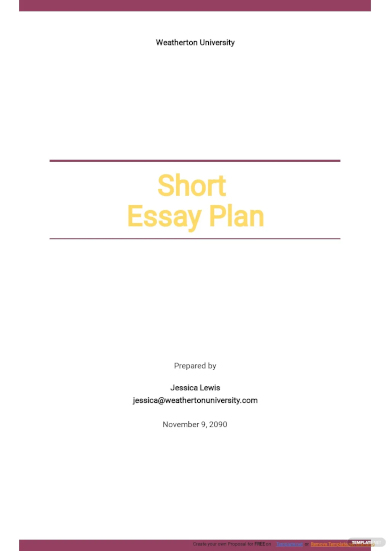
Biographical Narrative Essay Example

College Narrative Essay Example
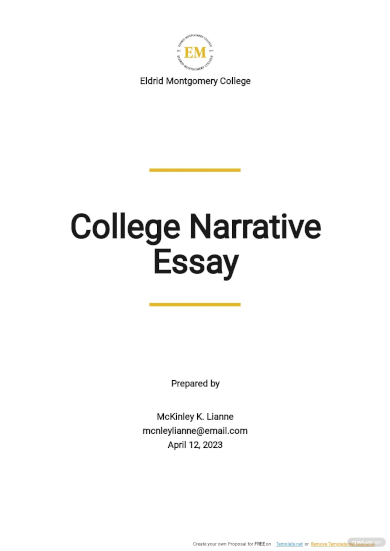
Personal Narrative Essay Example

Short Narrative Essay Example
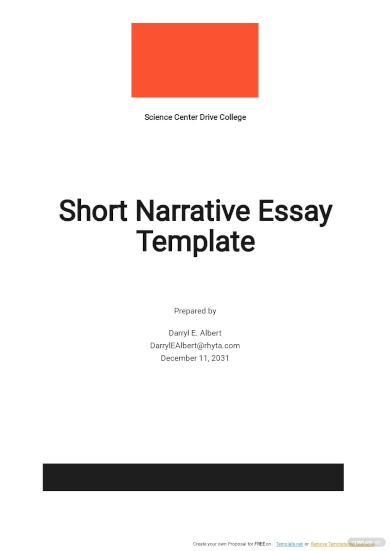
High School Descriptive Essay Example

Free Simple Descriptive Essay Plan
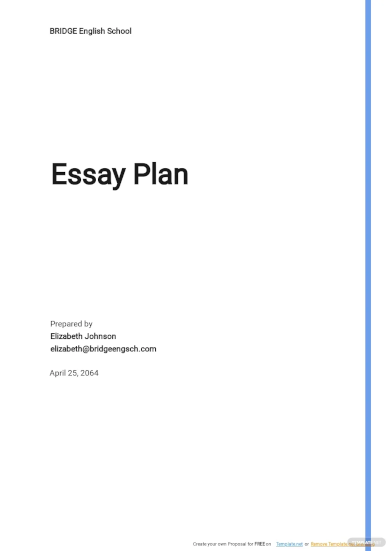
Basic Descriptive Essay Writing Example

latterdaylearning.org
Short Descriptive Essay Example

trudyamiller.wikispaces.com
Descriptive Essay Structuring Example
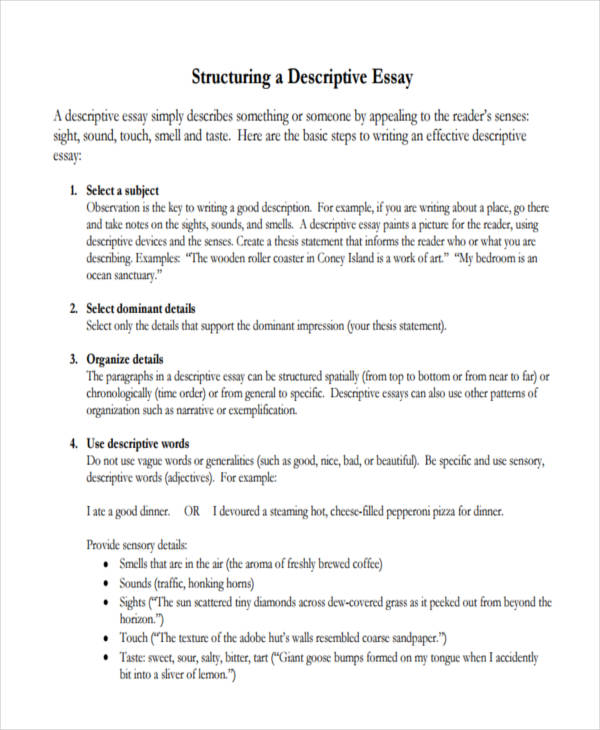
colegiobennett.org
Simple Descriptive Essay Example
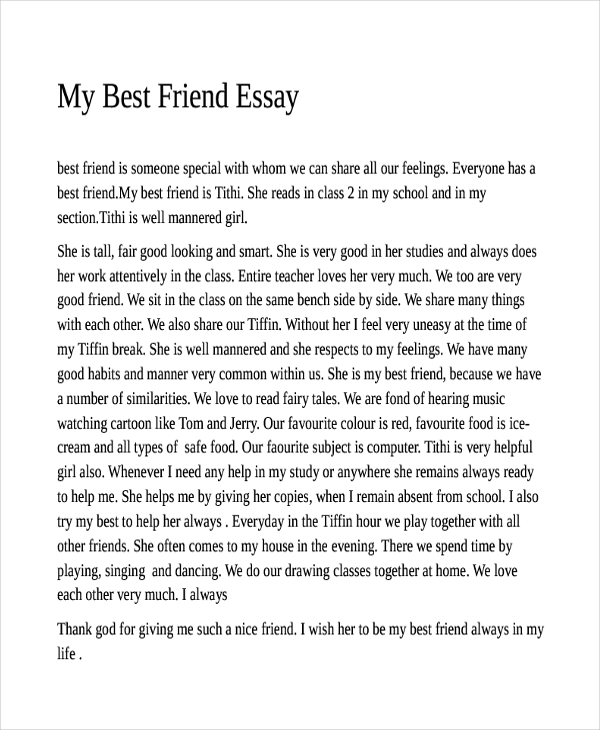
essssay.com
Narrative Descriptive Essay Example

preservearticles.com
Descriptive Essay Prewriting Example

fileserver.net-texts.com
Personal Descriptive Essay Example
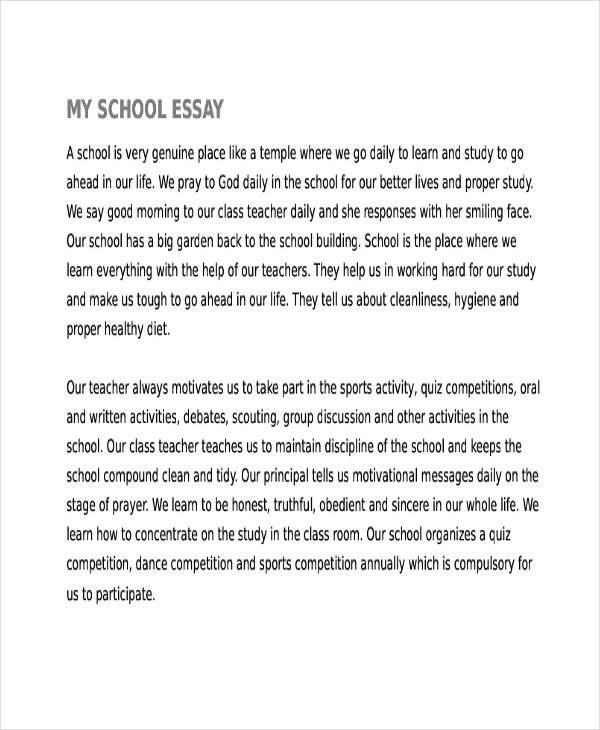
indiacelebrating.com
Descriptive Essay Characteristics Example

Descriptive Essay Description Guide Example
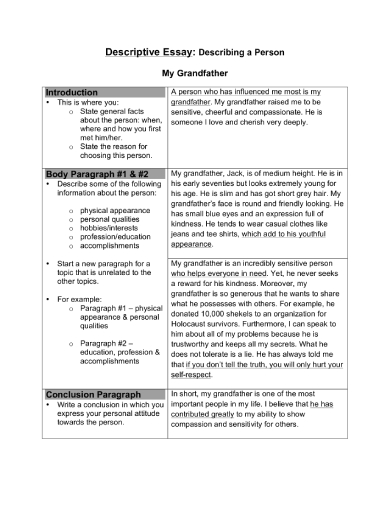
ortbinyaminaenglish.yolasite.com
Descriptive Essays about Places Example
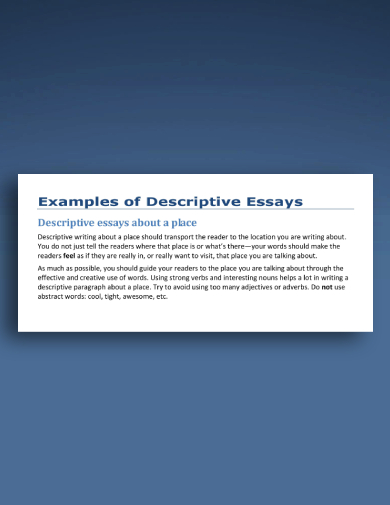
Excellent Descriptive Essay Example
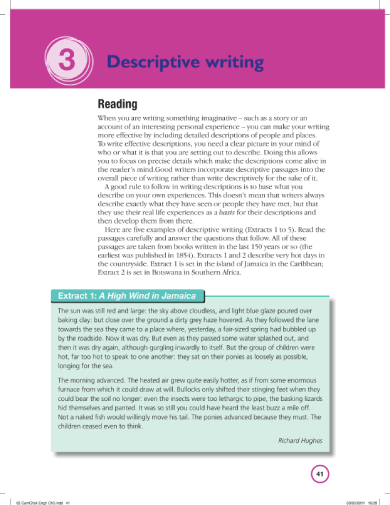
hoddereducation.co.uk
Descriptive Essay Writing Exercise Example

Educational Descriptive Essay Example

owll.massey.ac.nz
Spring Break Descriptive Essay Example
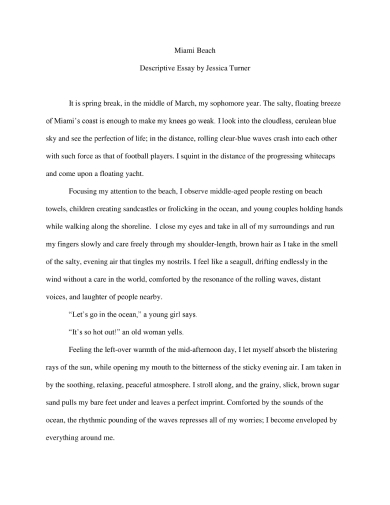
cheylin.com
Descriptive Essay Sentence Writing Example
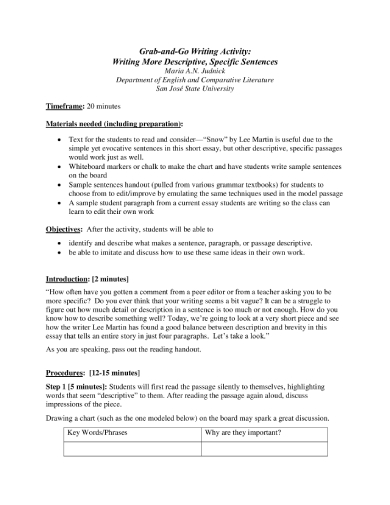
Descriptive Essay Paragraph Guidelines Example
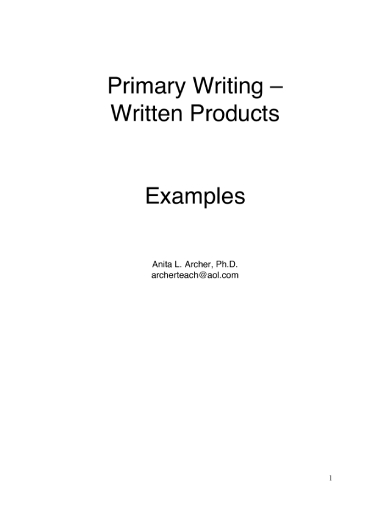
Stylish Descriptive Essay Rubric Example
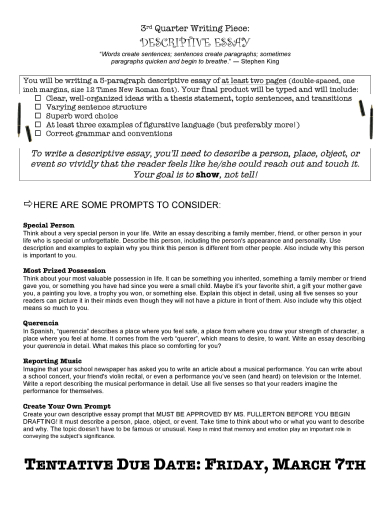
Descriptive Essay Writing Techniques Example
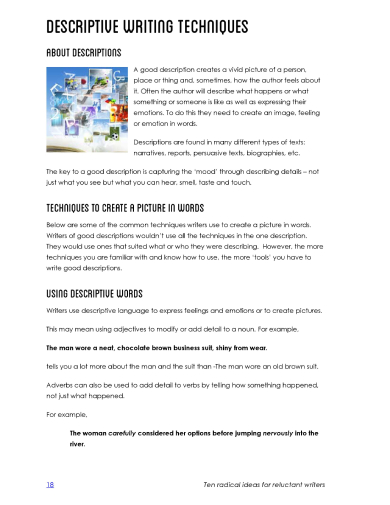
multifangled.com.au
Free Descriptive Essay Example
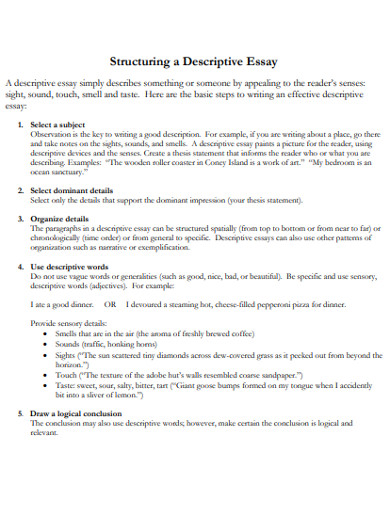
asc.weebly.com
Basic Descriptive Essay Example

hortonskids.org
Sample Descriptive Essay Example

essaytigers.com
Descriptive Essay in PDF Example
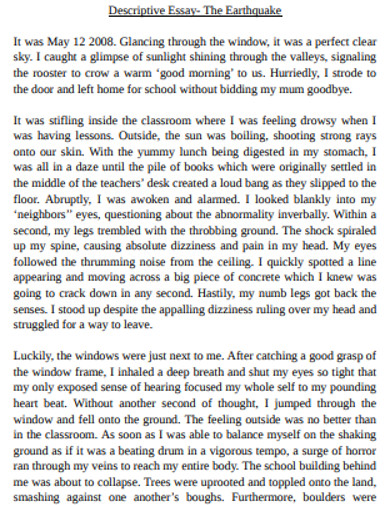
Printable Descriptive Essay Example
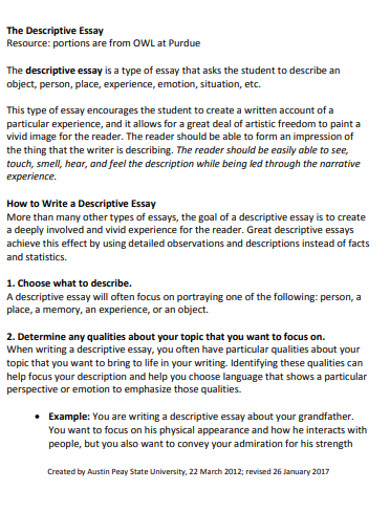
Direction Descriptive Essay Example
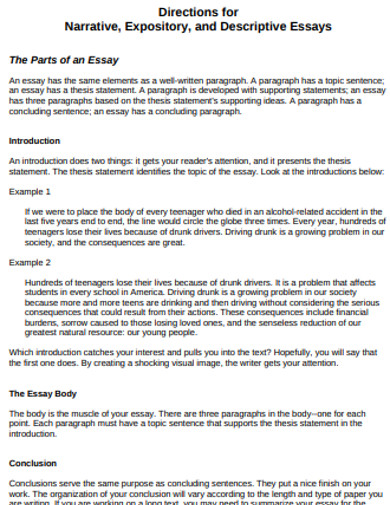
wba.aplusanywhere.com
Descriptive Essay Scoring Guide
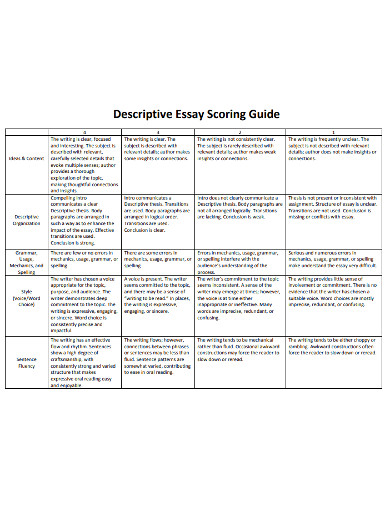
washoeschools.net
Professional Descriptive Essay

Descriptive Essay Format Example
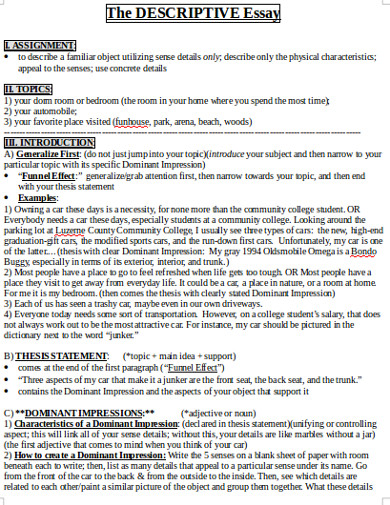
staff.kings.edu
Assignment Descriptive Essay Example

fd.valenciacollege.edu
What are the 4 types of essays?
An essay is an extended piece or composition that shows and supports a thesis or proposition. Essays help the expression of an author’s ideas in various ways. Before composing your own essay, it is important to identify its purpose first, and in doing that, distinguishing its type would be a great beginning. Correspondingly, here are the four different types of essays:
Narrative Essays: to tell
Taking it into its most basic sense, narrative essays are used if the author wants to tell a story about a real-life adventure. This type of essay is expressed in a particular point-of-view. Commonly, it is the author’s viewpoint that is being followed. Moreover, in writing your own short narrative essay , apply realistic emotions and appropriate sensory details to provide your readers with the full taste of your story. By doing this, you are not simply telling them but also engaging them in the story’s sequence and elements. It is also advisable to state verbs as vivid and as precise as possible. The thesis statement of a narrative essay is commonly found in the opening sentence or the last sentence of the introductory paragraph.
Descriptive Essays: to describe
You may confuse yourself between narrative and descriptive essays ; however, differentiating both is really easy. Rather than telling a story, a descriptive essay illustrates a specific topic such as a person, place, experience, emotion, event, etc. by means of words. You don’t simply state your experience in this type of essay; on top of that, you let your reader experience the same thing through your descriptions. In writing your own short descriptive essay , it is important to remember that you are not writing to tell but to show. Using sensory and vivid words is also recommended.
Expository Essays: to uncover and clarify
From its name itself, an expository essay is used to expose something on matters that are known to others. This type of essay is a genre of composition that aims to explain, illustrate, clarify or explicate a certain subject for the readers. Thus, an expository essay could include investigation and evaluation of ideas. This could be derived through comparison and contrast, definition, giving examples, assessment of cause and effect, etc. Moreover, in composing an expository essay, the author set his/her emotions aside for this type of essay is based on mere facts. The first point-of-view is not applied in this essay as well.
Persuasive Essays: to convince
If the expository essays talk about the facts then persuasive essays talk about arguments. The main purpose of a persuasive essay is to win over the trust of the reader to accept your viewpoint, opinion or proposition as the author. In writing a persuasive essay, your opinions should be supported by relevant facts and logical and sound reasoning. Though the essayist should lay all necessary details from both sides of the argument, he/she must comprehensibly explain why one side is correct or more favorable than the other.
Despite essays being categorized into four types, it is also important to know that an essay is not limited to one type only. In some cases, a narrative essay could also be mixed with a short descriptive essay or a short persuasive essay combined with an expository type. Nevertheless, identifying the purpose of your essay is vital before writing. However, if doing it challenges you, knowing these types is a great substitute.
What Is the Purpose of a Descriptive Essay?
Some people like to watch movies rather than to read books. This is because an actual image is easier to absorb than that on writing. This is why it’s important for a writer to pay close attention to detail. A descriptive essay conclusion should provide the reader with a mental picture of a given matter.
This is especially essential when writing pieces meant for a younger audience, as they have a more imaginative mind than the average adult. A writer must be creative when using imaginative language in order for the reader to properly comprehend what is being portrayed. To do so, the writer should also be knowledgeable about the topic. After all, you don’t want to give your readers the wrong interpretation .
How to Write a Descriptive Essay
A good descriptive essay comes from a knowledgeable and imaginative mind. Thus, in descriptive writing , it’s important for one to be specific on details. After seeing a few samples that we have shown earlier, here is a step-by-step guideline to help you in composing a descriptive essay worth reading.
1. Choose a topic.
If there is no given topic, it would be great to select one that you are knowledgeable and familiar with. Considering that your whole descriptive essay would revolve on this specific subject, choosing a topic that you recognize would keep everything simpler for you. By doing such, you can freely decide what words are the most appropriate to use; as a result, it will be easier for you to describe your topic. Furthermore, your reader could be meticulous and educated on your subject, so being knowledgeable about your own topic is wise prevention against bad impression.
2. Construct your thesis statement.
Alright, now that you have your own topic already, it is important to know what specific message you want your reader should focus on reading your whole essay. Thus, it is important to always provide a thesis statement , the umbrella sentence of all your ideas. Write this in one concise sentence in your introduction and conclusion. Often, a thesis statement is mentioned in the last sentence of your introductory paragraph.
3. Gather the necessary information and ideas.
Though you are already proficient in your topic, it is still recommendable to research about your specific subject. With this, you are not just gaining new information but also checking the correctness of your knowledge. It would also be great to expand your vocabulary, especially in adjectives and adverbs, since writing one of these involve loads of describing. Moreover, also focus on the sensory words that correspond to sight, smell, taste, sound, and touch of the given subject.
4. Create an outline.
Obtaining all of the significant details, crafting an essay outline for your work will allow you to arrange your contents in a rational and chronological order. Also, being educated with different formats in writing an essay would really make a great difference in your composition.
5. Proofread.
After writing your own descriptive essay, it might feel perfect already, but most of the time, it is not. Hence, read your entire work and review if there are any errors pertaining to your grammar and spelling. Furthermore, asking for help from a well-versed friend of yours to conduct a peer-review to your work would be extremely useful.
6. Finalize your composition.
The next thing to do after the editing is to finalize your descriptive essay to its finest version. Make sure that your essay follows a specific format, consisting of the proper parts of the essay .
Smart Tips for Writing a Descriptive Essay
The fundamentals of the descriptive writing procedures are now given to you; nevertheless, it would always be great to aim for something better. Now, here are some intelligent tips that would make your essay certainly more compelling.
Establish a connection with your writing.
The key to writing a good effective essay is to have the passion to write it; thus, in choosing your topic it would be great to have a familiar one or a subject that truly makes you curious. Let your interest be the seed of your fruitful composition.
Spend time to think.
In writing your own descriptive essay, let your brain do its job. Do not rush, give yourself an adequate amount of time to ponder on the necessary details that you should include and what approach you should apply. Provide yourself a clear plan of your descriptive essay writing. Moreover, look at your topic from different angles. This will allow you to take a closer look at every detail of your subject.
Apply the word vomit technique.
The word vomit technique or also called as “ free writing ” is the spontaneous use of words without considering any rules. This is a good technique in making a draft of your starting an essay . It allows your ideas to keep flowing without exerting much effort. Once this is done, you can pick out points that would go well with your essay.
Take a break before finalizing it.
Because right after writing your composition, your thought highly recognizes your word construction; thus, it does not really notice the errors and automatically treats them as correct pieces of your work. Allowing your mind to clear out for a while will make it easier for you to critic your own work. Furthermore, utilizing grammar-checking software is also a splendid move.
Text prompt
- Instructive
- Professional
Write a descriptive essay about a place you love to visit and what makes it special.
Describe in a descriptive essay your dream job and what it would be like to work there.
- How it works
- Pay for essays
- Do my homework
- Term Paper Writing Service
- Do my assignment
- Coursework help
- Our Writers

How to write a narrative essay to score top marks

With a Juris Bachelor's degree and a decade of legal practice, Darious Davson excels in creating compelling and authoritative academic papers in Law and Ethics. His work is a testament to his profound knowledge of the legal system and commitment to upholding ethical writing practices. So, this experienced paper writer is your top-tier pick!
How to write a narrative essay? This task has never been an easy task for students. The fact is that it requires showing off your experiences, life-changing moments, and outstanding events that had an impact on your personality. So, what is the main challenge of a narrative essay, and how to write it?
First, it is difficult to determine the moment you want to describe. Second, the writing process itself requires excellent skills and the ability to convey facts excitingly. Moreover, you need to understand the requirements and choose a suitable format. And all this is just the top of a glacier!
However, there is good news. I’m here to help! So, get ready to find the answers to the crucial questions about effective writing right here.
Let’s begin with identifying the core features of personal narratives. What do most successful academic papers have in common?
- First-person perspective: The key feature of this type of paper is that it must be written in the first person. You need to write about yourself, not your favorite artists or teachers.
- Engaging opening: Your essay must grab the readers' attention from its first lines.
- Detailed descriptions: Each sentence matters. Don’t be afraid to add bright descriptions of the environment, mood, and other aspects that make your story unique.
- Emotional resonance: Your essay should touch the hearts of the readers. Avoid composing a long monologue with a list of simple facts.
- Clear goal: According to the narrative format rules, your paper must not be a biography or a story without a clear purpose. Make sure it has an easily recognizable goal.
Logical organization: Looking at most narrative essay examples, you will notice that they all have a logical flow.
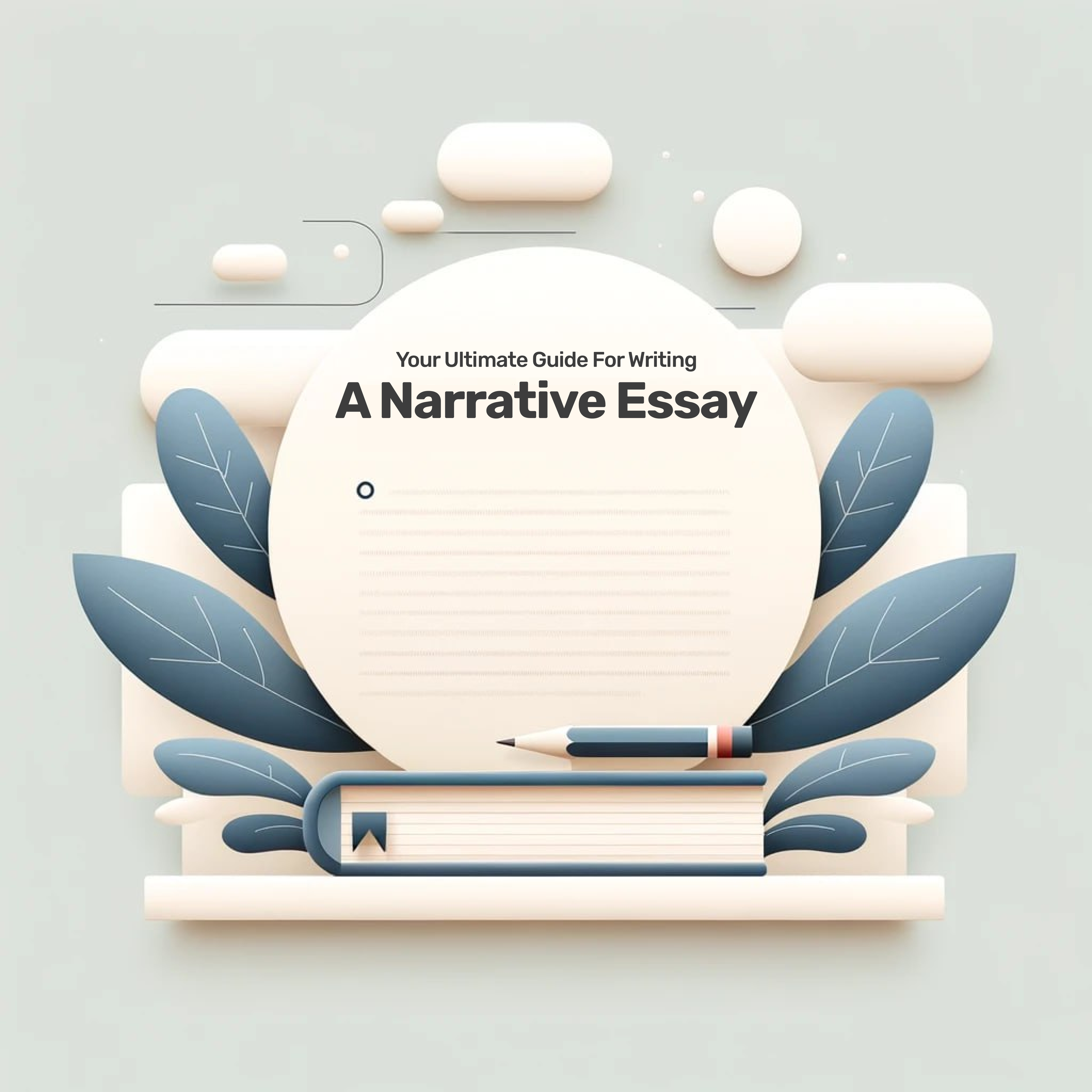
When writing a narrative essay, you must follow the main rules of completing this academic assignment. To make your job easier, I developed this guide to cover all the questions and blind spots most students usually face. So, it’s high time to discover all the critical aspects of crafting an excellent paper.
What is a narrative essay: defining the concept
Before you jump into writing and exploring the main rules for this tricky academic paper, it is necessary to have a closer look at the basics. So, what is a narrative essay? The main thing you need to know about it is that it must be a unique story from the writer’s viewpoint. As a rule, it covers topics related to your experiences, events, and memories. However, your writing shouldn’t be a monotonous bunch of facts. Make sure to describe facts easily, interestingly, and engagingly.
Unlike other types of academic papers, a personal narrative puts storytelling first. You can also use the following elements to make your story catchier:
- Diverse descriptions;
- Chronological order.
Grasping the Fundamentals of Narrative Essays
You can effortlessly find many narrative essay examples online. However, you need to know that college and high school papers of this kind usually have some differences. Moreover, each one usually has a long list of requirements and unique features. Here is a list of what you should take into account when exploring the needs of narrative writing:
- Essay structure;
- Paper length;
- Style of writing;
- Rules for creating a thesis statement;
- Requirements for the introduction;
- Requirements for the body paragraphs;
- Requirements for the conclusion.
Even experienced students often feel lost when facing this type of academic assignment. What is more, this challenge makes them ask one crucial question: “Is there anyone who can write my essay for me?”. This issue disturbs even the most talented and skilled students. Fortunately, there are professional writing services that are always ready to help. But if you still want to complete your assignment yourself, it’s time to choose a topic!
Top narrative essay topics for academic success
There are hundreds of narrative essay topics available online. Still, I highly recommend you develop your own. Feel free to use the tips below to identify your only idea.
- Think of your experiences: This prompt might sound obvious. However, many students often start by looking for ideas online or asking artificial intelligence platforms to generate a list of possible solutions. But what about diving into your own memories?
- Find out particular lessons: You surely have a particular experience that shaped your character. What about telling about it in your personal narrative?
- Don’t think only about yourself: Your audience matters, too! Select an intriguing and relevant topic that will not make your readers yawn.
- Make a list: Sometimes, you might invent a few personal narrative topics that look good. Write all your ideas down. The reason is that a chosen idea might suddenly turn out to be unsuitable when you start writing. For this case, you need a plan B (or even plan C).
- Choose an uncommon angle: If you select a common topic, you must find a unique approach to describe it. Try to add some fresh ideas to your storytelling.
- Test: If you can’t choose a topic between several alternatives, try to compare them. You can also draw a small draft for each to define narrative writing that will likely suit all your requirements and expectations.
- Listen to your gut: Intuition works not only to teach important life lessons. It might help you with choosing a good topic, too.
Narrative essay examples
You may use dozens of literacy narrative topics and other solutions for your paper. Here is a list of some ideas for you:
- A Moment of Courage: Overcoming a Fear That Changed My Life
- Lost and Found: A Journey of Self-Discovery during Travel
- The Day Everything Changed: A Personal Reflection on a Major Life Event
- Lessons from Failure: How Setbacks Have Shaped My Character
- An Unforgettable Friendship: The Story of a Lifelong Bond
- From Dream to Reality: Pursuing a Passion against All Odds
- The Power of Forgiveness: Healing Wounds and Moving Forward
Crafting an excellent narrative essay structure
After you’ve decided on a topic, it’s time to build a skeleton for your essay. Learners often have issues when creating their first narrative essay structure. Still, if you understand the basic elements of your paper, you will get almost half of the job done:
- Plot: It is a sequence of events that organically come one after another in your story. Avoid jumping between facts from different parts of your paper.
- Characters: Of course, you must be your story’s protagonist. However, don’t focus only on your personality. There should be other people, too.
- Setting: This is a description of the environment where your story takes place. Pay more attention to this part, as it can spice up your narration.
- Dialogs: Double-check whether all the dialogues add value to your personal narrative and are realistic.
- Climax: This is the heart of your story. It is better to describe it with the highest tension and feature-rich facts.
- Final: This is the resolution of your story. After you’ve reached a final thought, you can add a brief summary and end your paper.
Narrative essay outline: top prompts
Now that you know your paper's critical elements, it’s time for a narrative essay outline. As a rule, it must have a chronological order and traditional essay structure:
Introduction
- Hook: Similar to many other academic papers, your narrative should have a hook and a good-looking opening sentence. Make sure your intro attracts attention and doesn’t look obvious or boring. A good introduction is one of the keys to receiving an excellent grade for your assignment.
- Background: Here, you are expected to describe some settings, characters, and minor details to allow the readers to imagine your story better.
- Thesis statement: Your thesis statement must briefly describe the main goal of your narrative writing.
- Flow of events: Your paragraphs should be organized and chronological. Always follow your story’s timeline.
- Dialogs: Although the traditional narrative essay format doesn’t require using dialogs, most students add them to their papers. This approach allows them to describe all the events and characters much easier.
- Reflection: Remember that your essay must demonstrate your feelings and emotions.
- Summary: Almost any academic paper requires a short and powerful summary. Personal narratives are not an exception to this rule.
- Reflective end-up: Use your closing to connect with the thesis.
- Impression: Try to leave an impression on the readers and make them think about your paper a few moments after you’ve finished it.
Types of narratives: learning from examples
There are several types of narratives you need to distinguish:
- Personal: Focuses on a specific experience or event. It usually shares insights or lessons learned.
- Descriptive: This one usually describes a scene or event with the help of diverse sensory details.
- Autobiographical: This solution recounts the author's life story and highlights milestones, challenges, and achievements.
- Travel: Documents the author's experiences and observations during traveling.
- Historical: This narrative writing recounts significant historical events or periods from a personal perspective, blending historical facts with reflections.
- Literary: Explores themes, characters, and motifs of a literary work or genre, offering personal interpretation.
- Ethnographic: Draws on the author's observations within a cultural or social context, offering insights into individuals or communities.
The narrative essay definition for high school students is not difficult. Moreover, it’s the same for all learners. However, you are expected to tell a story about the most important lessons in your life and share something meaningful for you. It shouldn’t be only funny or entertaining. You may also describe how you’ve made mature choices and the right decisions (regardless of how tough they were.)
If you google “define narrative essay for college students,” you will find out that it is developed to demonstrate your best qualities through the description of a particular life event. Don’t hesitate to put your creativity into practice and use unique writing approaches. A few things most professors value in this type of academic paper created by college learners:
- Your ability to be flexible and adapt to drastically changing life situations;
- Your creative problem-solving skills;
- Your ability to take lessons from the mistakes you’ve made.
How to write a narrative essay: tips to achieve top marks
- Choose a compelling topic: What is the purpose of narrative writing? Make sure you find the answer and then select a meaningful topic.
- Create a strong thesis: Develop a clear thesis statement that conveys your narrative's main message or lesson.
- Use vivid descriptions: Engage the reader by incorporating sensory details and descriptive language to picture the events and characters vividly.
- Establish a clear structure: When writing a narrative essay, organize it chronologically. Develop a clear beginning, middle, and end.
- Maintain a consistent point of view: Stick to a consistent narrative perspective throughout the essay.
- Include dialogue: Dialogs can bring your characters to life and add authenticity to your narrative.
- Show, don't tell: Instead of simply stating events, you must show them through actions, emotions, and sensory experiences.
- Reflect on significance: Reflect on the event's significance and share insights when writing a narrative essay.
- Edit and revise: Don’t forget to revise your essay for clarity, coherence, and impact.
- Seek feedback: Get feedback from peers, instructors, or mentors to improve your narrative.
Many students report serious difficulties with completing a narrative academic assignment. Can I pay someone to write my paper? Hundreds of learners often ask this question. And the answer is “Yes!” In this case, you will get a perfectly written, proofread, and original paper crafted according to all your requirements.
But what if you decide to write on your own? This way, the best answer to how to write a narrative essay is to understand its core concepts and strictly follow your professor’s guidelines.
FAQs on writing brilliant narrative essays
How can i make my narrative essay stand out from others.
Many narrative essay ideas can be found online. However, to stand out, it is better to find a unique topic for your assignment.
What are common mistakes most students make in narrative writing?
The most common mistakes in a personal narrative are failing to follow an essay structure, failing to include a thesis statement, and sharing too many diverse facts.
How can I revise my narrative essay?
You must review your paper for clarity, consistency, and coherence, edit grammar and mechanics, enhance descriptive language, trim unnecessary details, check a narrative format, ensure a strong conclusion, and conduct a final proofread.
Should I use dialogues in a narrative essay?
This rule is not 100% obligatory. However, if you search for successful narrative essay examples online, you will discover that almost all have dialogs.
What are the best ways to improve the essay’s flow?
Use a chronological order and a strict timeline when polishing your academic paper.
Related posts

How to Restate a Thesis | Your Student-Friendly Guide With Examples

What is a research paper: a comprehensive exploration and detailed guide

How to Write an Evaluation Essay | Your Academic Guide
What are you waiting for?
You are a couple of clicks away from tranquility at an affordable price!

IMAGES
VIDEO
COMMENTS
Narrative vs. Descriptive Essays. When it comes to writing essays, there are two main types: narrative and descriptive. While they may seem similar, they have distinct differences in purpose, structure, and examples. Purpose. The purpose of a narrative essay is to tell a story. It typically includes characters, a plot, and a setting.
The key difference is that a narrative essay is designed to tell a complete story, while a descriptive essay is meant to convey an intense description of a particular place, object, or concept. Narrative and descriptive essays both allow you to write more personally and creatively than other kinds of essays , and similar writing skills can ...
The key difference is that a narrative essay is designed to tell a complete story, while a descriptive essay is meant to convey an intense description of a particular place, object, or concept. Narrative and descriptive essays both allow you to write more personally and creatively than other kinds of essays , and similar writing skills can ...
The key difference is that a narrative essay is designed to tell a complete story, while a descriptive essay is meant to convey an intense description of a particular place, object, or concept. Narrative and descriptive essays both allow you to write more personally and creatively than other kinds of essays, and similar writing skills can apply ...
Key Differences. Purpose: Narrative essays tell a story with a moral or message, while descriptive essays create a vivid picture of something by using sensory details. Structure: Narrative essays have a story with people, events, and a specific order. Descriptive essays are all about the words and senses, usually not sticking to an exact timeline.
Differences Narration often employs first person point of view, using words like "I" and "me," while other modes including description do not. The biggest difference between the two is that a narrative essay includes action, but the descriptive essay does not. Narration follows a logical order, typically chronological.
A narrative essay is written to narrate a certain incident or experience while a descriptive essay is written in order to describe a person, a thing, or a place. In a narrative essay, first person point of view is generally used and both first and third points of views are used in a descriptive essay. A narrative essay uses a logical, more ...
Narrative Vs. Descriptive Writing. The most common types of writing assignments students encounter in composition classes are exposition, argument, narration and description. While all these modes allow a writer to explain an idea or event, they differ in the specific intent. A narrative tells a story about an event, ...
The most difficult part of a narrative essay is its narrow focus while the most difficult part of a descriptive essay is its organization. Frequently students are asked to write a narrative essay that includes lots of description; thus, these two modes have been combined into one guide. Take what you need from the guide and ignore the rest.
The distinction between a descriptive and a narrative essay is one grounded in a theory concerning the "modes" of rhetoric that was very popular in the 1950s and 1960s, and is still used in some ...
A descriptive essay's primary goal is to captivate the reader by writing a thorough and vivid explanation of the subject matter, while appealing to their various senses. A list of additional goals is as follows: - Spark feeling and imagination. - Create a vivid experience. - Paint a mental picture. - Pique curiosity.
Not every form of essay writing involves meticulous research. One form in particular—the narrative essay—combines personal storytelling with academic argument. Narrative essay authors illustrate universal lessons in their unique experiences of the world. Below, you'll find some tips to guide in this style of narrative writing. <br> ## What Is a Narrative Essay? Narrative essays make an ...
13. Instead of unfolding a series of events, it emphasizes sensations, emotions, and observations, encapsulating a moment in time. 6. While a "Narrative Essay" provides a clear beginning, middle, and end, the "Descriptive Essay" can capture a single, static scene or emotion. However, it's worth noting that both essay types aim to engage readers ...
Yes, an essay can combine descriptive and narrative elements. A well-crafted essay can use descriptive language to vividly portray scenes and events while incorporating a narrative structure to tell a story, engaging readers on both sensory and storytelling levels for a richer experience. I know the difference between narrative and descriptive ...
A descriptive narrative essay is often confused by students due to the similarities between a descriptive and narrative essay. Both of these essays can be written by people of any age as they don't contain facts but rather involve a creative approach. This article will guide you through the difference between descriptive and narrative essays in detail.
Seasoned writers weave descriptive and narrative writing to create compelling reading, but the two styles have distinct purposes and features emerging writers need to master separately. Descriptive writing attempts to capture the details of a topic and accurately portray its elements to readers. Narrative writing ...
Differences of these papers. In a narrative essay, you should tell a story from your own point of view and use such phrases like "I think", "In my opinion", and so on. In a descriptive paper, you should be objective in your writing. Also, narrative papers often include actions, while descriptive papers do not. A narrative paper follows ...
Differences Between Descriptive Essay Vs. Narrative Essay. This section is dedicated to covering the differences between writing a descriptive essay and a narrative essay. The differences range from the primary motive to literary devices, a range of subjects, and more. Students should keep in mind that the main difference between the two is ...
Your essay will use both, but focus on the description, because that's what your assignment calls for. Your telling the tale creates a narrator, but the narrator is not your focus. Description is the evoking of images. Narration is the process by which you evoke the images and tell the story. answered. Cyn.
Furthermore, a Descriptive essay demands an essay writer to explicate a thing, person, place, etc. In contrast, a narrative essay requires a student to narrate a story of his personal life experience. Next, a scribbler cannot suggest or recommend anything in a Descriptive essay the same as he does in a Narrative essay.
The Difference between an Essay and a Narrative. ... There are four basic types of essays: persuasive, expository, descriptive, and narrative. A narrative essay tells a story in a first-person point of view to make a specific point. What is A Narrative? In short, a narrative is any story told in first-person through the recounting of a sequence ...
A descriptive essay is a type of writing that aims to vividly describe a person, place, object, or event. In this type of essay, the writer uses sensory details such as sight, sound, smell, taste, and touch to create a clear and vivid image in the reader's mind. The goal of a descriptive essay is to evoke a strong emotional response or create ...
Engaging opening: Your essay must grab the readers' attention from its first lines. Detailed descriptions: Each sentence matters. Don't be afraid to add bright descriptions of the environment, mood, and other aspects that make your story unique. Emotional resonance: Your essay should touch the hearts of the readers.